19 Towers, 22 Days
a sample itinerary for completing the All-Japan Tower Association Stamp Rally
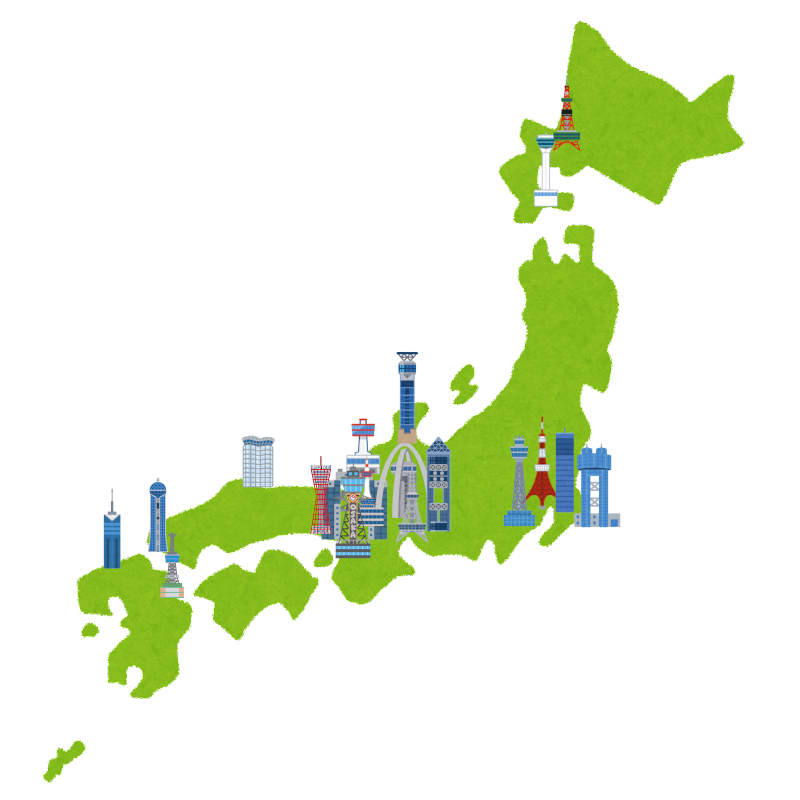

The All-Japan Tower Association Stamp Rally. I’m not sure where I first heard of it, but I feel like it’s been left to simmer somewhere in the back of my head for a while now. I’ve been to a couple of the towers in it, so perhaps while in the visitors center/gift shop for one of them, I happened to notice something regarding the stamp rally, since that’s the exact sort of thing that catches my eye. Lately, though, I’ve been in one place for long enough again for my mind to fill with travel, and for the first time in a while, it’s turned to that forbidden fruit of the past two years: Japan. Maybe it’s just a case of “Nostalgia of Island”, but another trip is definitely on the table, eventually. The only issue is that I’ve been there, done that a few times already, so when I sat down and started thinking of where to go next time in Japan, I got what I suppose you could call “traveler’s block”. Then, while looking for fresh travel ideas by sifting through the Japan part of my recollections, something bubbled over and grabbed my attention: The All-Japan Tower Association Stamp Rally. It sounds crazy but this could be it, I thought as I looked up details online.
Completing the All-Japan Tower Association Stamp Rally is simple: within one year, visit and collect a stamp from all 19 towers across Japan in the All-Japan Tower Association. Your reward? An official certificate and your name immortalized in the online register on the Tower Association website; in brief, eternal glory. It’s equal parts silly and serious, the perfect fit for me. I also like how it can give a theme, a narrative, a story to a trip. You’re not just some schmuck tourist randomly stumbling between the sights featured in the collages on Wikipedia pages for cities, no, you’re on a Quest, a Journey. You have concrete steps that build towards an ultimate goal, however dubious it may be. Finishing your trip successfully becomes an actual accomplishment, one that is in fact more impressive than many achievements people are proud of, when you think about it. Take, for example, getting a college degree. At this point, hundreds of millions of people have graduated from college, but only around 1400 people have completed the All-Japan Tower Association Stamp Rally. As Westerner, it is even more impressive, since nearly all the finishers are Japanese, with the foreign ones almost all from other Asian countries (lots from Hong Kong, for some reason). There are only three that are definitely from the US, and none at all from Europe. It may be too late to claim the title of first Westerner or American to complete the Stamp Rally (damn it #458 ALEXANDER KRAMARCZUK USA MINNEAPOLIS), but it’s still an extremely exclusive club and good fodder for starting conversations, an About Me page, a dating profile, or a resume (maybe). (If you’re European, on the other hand, you’ve still got a chance to be a first! Get out there and go for it! Don’t forget to thank me in your acceptance speech...)
The Stamp Rally, obviously, is also the perfect solution to my “traveler’s block” issue. The travel destinations have all already been decided by the locations of the towers, and I just have to figure out the best way to link them together. As soon as I saw the map of the tower locations above, I knew that it was perfect. There was a good variety of towers – some were popular tourist destinations in big cities, some were offbeat tourist destinations in big cities, some were out in the middle of nowhere and trying very hard to be tourist destinations. They were scattered throughout the whole country, in such number at and such distances that you could string them together like beads on a rail necklace. The time limit for completing the stamp rally is one year, but you could conceivably visit them all over the course of a two- or three-week train trip. As someone in my position, who can only visit the country once every other year or so for a few weeks at a time, that was realistically the only way I was going to be pulling it off. It would be a bit of a whirlwind trip, moving between cities and riding trains for a few hours every day, but if anything, that’s a selling point to me. In fact, that describes my last Japan trip to a T, so now I could just repeat it, except with Towers.
All of this is also possible for me thanks to the venerable Japan Rail Pass, which, for those not in the know, might be the best travel deal in the world. For the duration you purchase it for (7, 14, or 21 days, $278, $444, and $569 respectively), you get unlimited, hassle-free travel on JR’s nationwide rail network (envied the world over), including the Shinkansen. As someone who both enjoys train travel and has a strong drive to get his money’s worth, I’ve always gotten train travel out of the rail pass that otherwise would have costed many times more than I paid. With the two or three week passes, you practically have to be willfully negligent not to get your money’s worth, since just three to four decent-length Shinkansen rides is enough to do so. It’s such a good deal that they have to restrict it only to foreigners on tourist visas, otherwise they would surely go bankrupt. Thanks to the rail pass alone, as a foreigner I actually have a huge cost advantage over domestic tourists when it comes to completing the Stamp Rally, albeit with a pace requirement that may turn some people away. Maybe that’s why you don’t see very many foreigners completing the stamp rally, despite the Japan Rail Pass being almost the perfect fit for a quick attempt. They don’t record (online, at least) how long it takes people to finish the Stamp Rally, and I do have to wonder where my Rail Pass Stamp Rally plan would land among them. It’s probably a good thing they don’t, though, since I just know that then I would be putting together a hellish itinerary consisting only of trains and towers, trying to use my Rail Pass advantage to beat the record.
Preliminaries
The basic trip structure will make use of a format that I’ve used before and thought worked quite well. It’s kind of a rail pass trip sandwich, with big city bread. You start off and spend a good amount of time, usually at least several days, in either Tokyo or Osaka, then depart and do a rail trip across the country for two to three weeks. You end the rail trip in the other big city, spend some time there, and then fly out from it. This structure works well for visiting the towers, since there are quite a few clustered around both Tokyo and Osaka, which you can visit at your leisure while you’re staying in those cities. The duration of the rail trip for this particular plan is two weeks, as I don’t mind keeping a brisk pace and spending several hours per day on trains, though for a more relaxed pace, it would be easy to extend it into a longer, three-week trip. Having a stricter time limit of two weeks for the rail portion of the trip also means that more cleverness and creativity, or just time spent planning, is required when with working out the itinerary, yet another draw for me.
Since the rail trip portion is two weeks, it would seem to make the most sense to get the two-week Japan Rail Pass and use it just during that portion, and that’s how I was originally thinking of doing things. After all, the two-week pass is cheaper than the three-week pass by about $125. Then, I finished the outline of the whole itinerary, and noticed that it was almost exactly three weeks long (plus one day), and still contained a significant amount of travel on JR lines to visit the towers located around the big cities at either end. There’s also plenty of JR lines within Tokyo/Osaka that would be useful for non-tower-related travel, if I even dare consider doing such a thing. I made some quick estimates considering just travel to the more far-off towers by Tokyo/Osaka, and I still think you would save around $30 using the two-week pass over the three-week pass, but it’s no longer so clear-cut. At that point, the convenience gains may be worth it, so I’m still not sure which one I’ll go with in the end.
The Itinerary Begins: Tokyo
Day 1
I chose to start this itinerary off in Tokyo rather than Osaka, since Tokyo has better air connections. I have started in Osaka before by flying into Tokyo and then taking a connecting flight, but that turned into a lot of fatigued shambling around Osaka that I would rather not repeat. I will just warn you that while the trains always run on time in Japan, the same cannot be said about the budget domestic airlines. I must give them some credit for attempting some particularly innovative cost-cutting techniques that I have yet to see elsewhere, such as printing boarding passes with regular receipt printers, using a bathroom scale to weigh luggage at check-in, and selling Cup Noodles for $5 as an inflight meal.
Anyways, once in Tokyo, three of the towers are basically gimmes: the Tokyo Tower (duh), Yokohama Marine Tower, and Chiba Port Tower. If you were so inclined, you could probably knock out all three of these in a day, but I think the more leisurely option of letting each tower anchor a day of sightseeing is better, which is how this plan will proceed.
Tokyo Tower
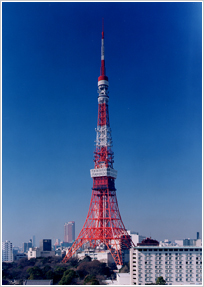
Tokyo Tower, the All-Japan Tower Association’s steadfast monarch. I have no definitive proof but I am reasonably certain that it operators have had a significant hand in forming and running the Association. I swear that is not a conspiracy theory although somehow it came out sounding like one. At any rate, it can still make a claim for the title on account of being the tallest (at 333m, a height that we are assured was definitely determined by scientists and engineers to fit the intended broadcast region and not by, say, occult numerologists) and most famous tower in the Association. The magnum opus of Japan Tower Design King Tachū Naitō, it was vaguely based on the Eiffel Tower in perhaps another example of Japanese Francophilia. Its distinct orange and white color scheme is to make it more visible to aircraft, a fate that I suppose the Eiffel Tower escaped because it was built before there were aircraft.
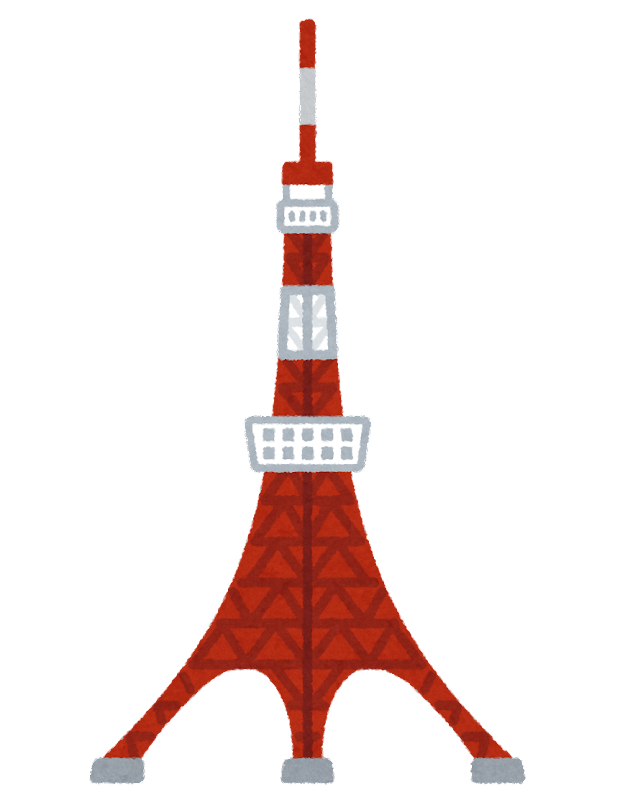
As a result of its landmark status, it’s one of the few towers in the Rally that I’ve actually already been to, and even up. If you’re a train man, it’s conveniently located a modest walk from Hamamatsuchō station on the Yamanote line, reasonably close to Tokyo station and the Imperial Palace, which you could also visit the same day. The tower itself is in a bit of a park-like clearing in the midst of the urban jungle, although among the vegetation and actual parks, there’s a few miscellaneous temples and fancy hotels. Inside the tower itself, they really seem to lean into the “tourist destination” angle, with an extensive souvenir shop and some sort of mini-theme park based on one of the big shonen franchises that may or may not have since been replaced with something equally dubious. I feel like there was a live jazz performance up on the observation deck the day I was there, but I may have imagined that.

Day 2
Yokohama Marine Tower
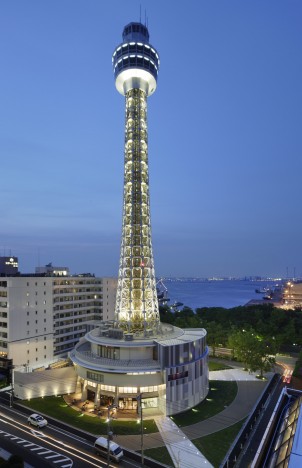
The Yokohama Marine Tower is one of the many towers that is built in the port/coastal area of a city. The reasons for why this is so common, at least in Japan, is still obscure to me. Is it nostalgia for the bygone days of lighthouses? Do people not want big towers built near them, so they are forced to put them in vaguely industrial port areas? Or maybe it’s so that if the tower falls over somehow, there’s a good chance that it harmlessly ends up in the drink nearby?
In any case, the poor Yokohama Marine Tower is now overshadowed by the nearby Yokohama Landmark Tower, Japan’s second tallest building and three times the Marine Tower’s height. I’m not sure if it’s this contrast that made me notice it, or perhaps the silhouette floor map on their website, but the shape of the Marine Tower reminds me of a chess pawn. Now there’s a good idea for some Tower Association merch, a tower chess set. I have, after all, already identified Tokyo Tower as the king, and now here we have the pawn. 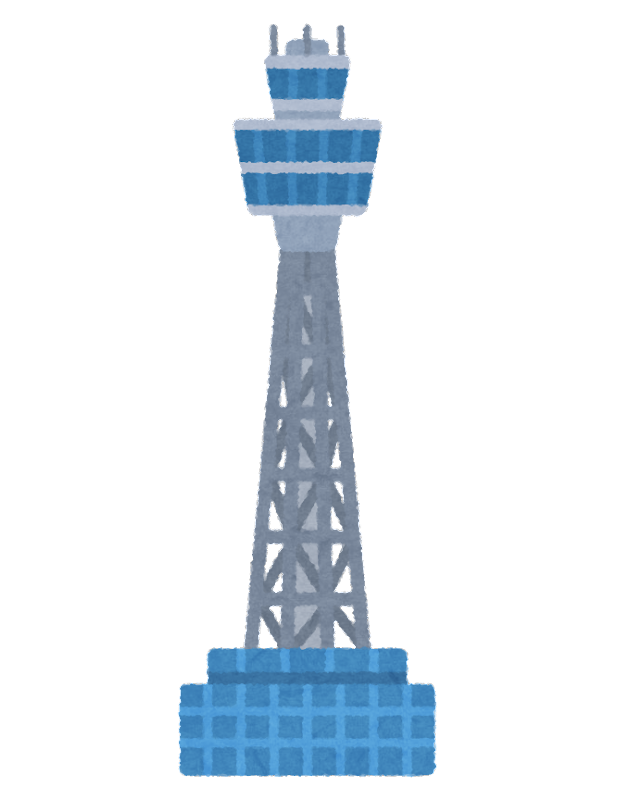 At least the Marine Tower is conveniently located in Yokohama’s so-called “Minato Mirai” coastal entertainment and sightseeing district, so it’s easy to fit it into a whole day of visiting the other attractions in the area like the old boat, Ferris wheel, the previously-mentioned Yokohama Landmark Tower, the curved escalator in the mall below it, the Cup Noodles Museum, and Yokohama’s Chinatown.
At least the Marine Tower is conveniently located in Yokohama’s so-called “Minato Mirai” coastal entertainment and sightseeing district, so it’s easy to fit it into a whole day of visiting the other attractions in the area like the old boat, Ferris wheel, the previously-mentioned Yokohama Landmark Tower, the curved escalator in the mall below it, the Cup Noodles Museum, and Yokohama’s Chinatown.
Day 3
Chiba Port Tower
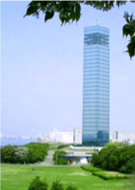
On the other side of Tokyo is Chiba, which has a lot less going on compared to Yokohama. It’s pretty much Tokyo’s Newark, an unpretentious, though particularly large, suburb. The only excuse I’ve ever found for going there is to visit Costco, which ended up being a horrible mistake (I will not elaborate). I wanted to make sure that I wasn’t being unfair to Chiba with this assessment, so I looked at its page on Wikivoyage, and guess what one of the sights listed was? Costco. I am not making this up. Wikipedia, on the other hand, offers up the “Kasori Shell Mound”, apparently the largest in Japan and among the largest in the world. Anyways, now there’s yet another reason to visit: the Chiba Port Tower. You could be boring and take the train straight to Chibaminato station, from which it is a brief walk from the tower, or you could take the train to Chiba station and then take the freaking SUSPENDED MONORAIL to Chibaminato station. 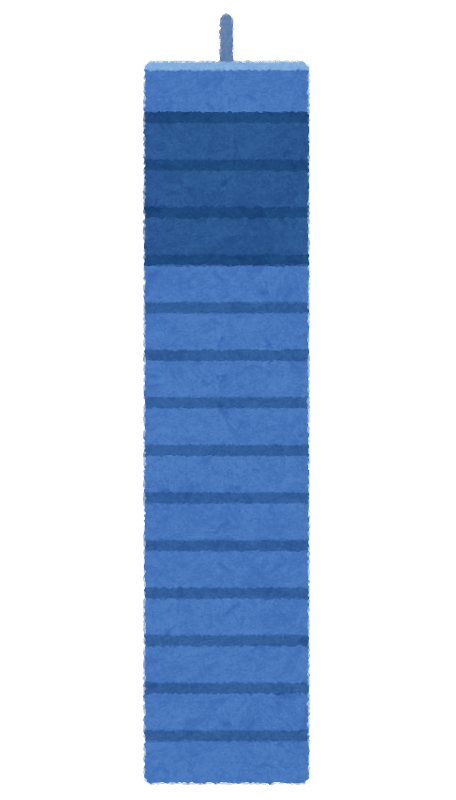 The easiest decision of my life. In fact, I was already thinking of going to Chiba for the suspended monorail alone. I may have been a bit disingenuous in my earlier description of Chiba by leaving it out, because it’s by far the city’s biggest selling point. Suspended monorails are phenomenally rare, and the one in Chiba is in fact the world’s longest. After riding the monorail to the tower, though, I’m not sure what else there would be to do in Chiba. Maybe ride the suspended monorail to the other terminus? Going to Costco again is out of the question.
The easiest decision of my life. In fact, I was already thinking of going to Chiba for the suspended monorail alone. I may have been a bit disingenuous in my earlier description of Chiba by leaving it out, because it’s by far the city’s biggest selling point. Suspended monorails are phenomenally rare, and the one in Chiba is in fact the world’s longest. After riding the monorail to the tower, though, I’m not sure what else there would be to do in Chiba. Maybe ride the suspended monorail to the other terminus? Going to Costco again is out of the question.
Oh, right, I forgot to say anything about the tower itself. From the name, you may have been able to guess that yes, indeed, it’s another tower built in an industrial port area. The only thing I can say about the design is that it seems appropriate for Chiba. Seems like it has a good view of the nearby ironworks, too.
Day 4
Choshi Port Tower
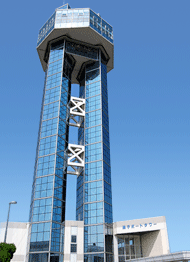
Earlier, I called the three previous towers “gimmes” if you’re staying in the Tokyo area, and now here’s the one that isn’t. It’s still relatively close to Tokyo, and wouldn’t fit in well anywhere else in the plan, so this is where it’s going to go. If you look at the coast of Japan to the east of Tokyo, past Narita, there’s a kind of pointy bit of land, like a giant pimple, or to the less refined mind, a nipple, and that’s where Choshi is. It’s not too difficult to get to, since Choshi station is at the terminus of the Narita rail line, and in fact there’s an express train that goes there straight from Tokyo station. It just takes a little while to get there, around two hours one way, so visiting this tower would definitely have to be a day trip. From Choshi station, you can take a twenty-minute local bus ride, or if you’re feeling spry, you can take the Choshi Electric Railroad three or four stations and then walk twenty minutes. I’m really not sure if there’s anything else to do in Choshi, but you never know what you’ll discover once you’re actually out there, pounding the streets and piercing the sky. Sometimes, just the vibes of these off (the) beat(en path) destinations is enough.
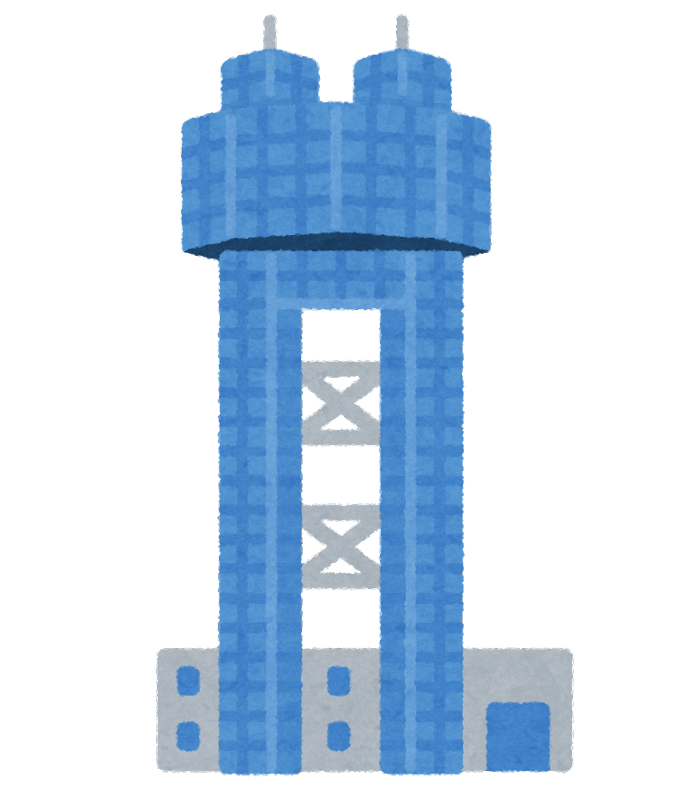
As for the tower itself, even the Tower Association website’s description is unusually concise. It appears to have been built to promote tourism in the area, and it’s certainly working at least a little, because otherwise I would have absolutely no business being in Choshi. True to the name, it is yet again another tower built in a port area, although at this one you can also taste what they bring in at the port, as it’s connected to some sort of seafood market by a bridge. The only other thing of note is that it was apparently in an episode of an anime called “Amagami SS”, where they took the artistic liberty of adding a glass floor area in the observation deck that is not in the actual tower. I hope nobody has made the perilous journey out to Choshi, only to find that they’ve been bamboozled once again by writers stretching the truth for plot convenience.
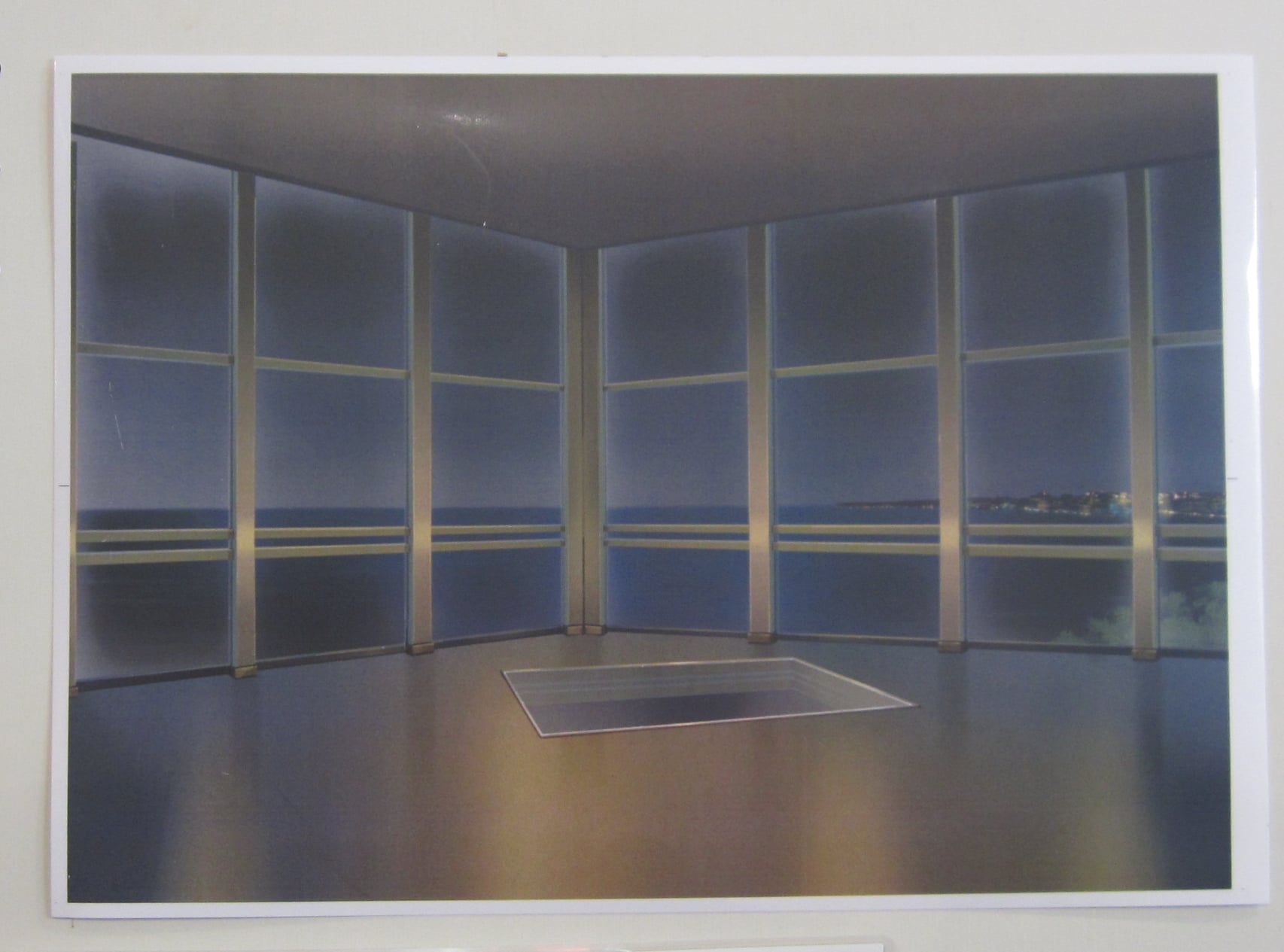
Bonus Towers Near Tokyo
Warning: True Tower Fanatics Only
Tokyo Skytree
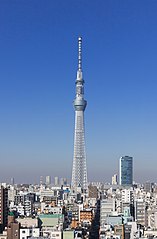
Yes, perhaps you’ve noticed it already, as it’s not really an obscure “true tower fanatics only” tower, but there’s one glaring omission from the All-Japan Tower Association (and Stamp Rally): The Tokyo Skytree. Why isn’t it in the Association? I’m not sure and did not research it at all, but maybe it’s just too high-and-mighty for the piddly little towers in the Association. After all, it’s literally the tallest tower in the world right now, almost twice as tall as Tokyo Tower. It’s still quite new, it’s hip, it’s flush with cash (I assume), they had the financial foresight to build a giant mall at its base, and finally, for the time being it doesn’t need to rely on silly gimmicks like a "stamp rally” to attract hordes of fawning tourists. But, a decade or two from now, maybe after they’ve built a tower twice as high somewhere currently towerless like Kawasaki, the washed-up Skytree is going to come crawling to the humble Tower Association and beg to be let in. Until then, you can visit the shiny new Skytree to feel what the atmosphere was like at Tokyo Tower in the sixties, or at the other towers when they were still young and hot.
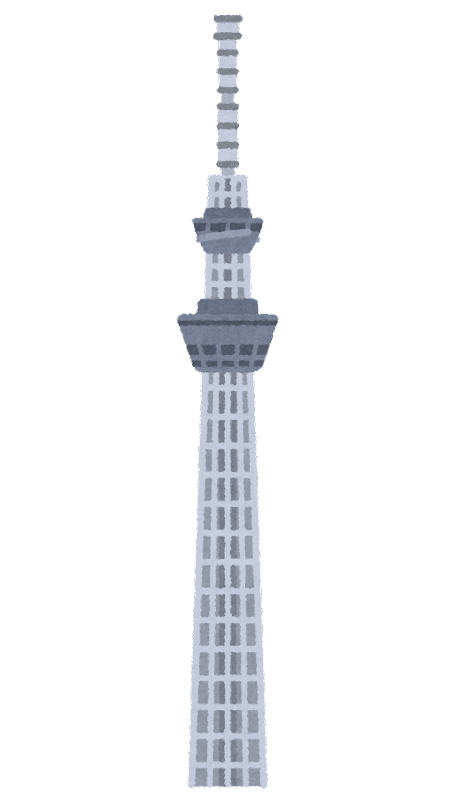
The Skytree may be the tallest tower in the world, but it feels even taller thanks to its prominence. It’s basically the Mount Fuji of towers. This is mainly because there are no other skyscrapers or tall buildings in its vicinity, other than the modest one that’s at the other end of the Skytree complex. Earlier, I speculated that perhaps a lot of towers were built in industrial port areas because people didn’t want big towers in their backyards, but the Skytree complex is like a volcanic island that popped up in the middle of a huge residential district. I feel like the people living in those modest 3-4 story houses all around it must constantly feel a vague sense of unease, with the Skytree intimidatingly looming above. I think it might be the most striking contrast in terms of neighboring building heights that you can find in the world. I can already imagine some scientist or analyst looking at a dataset of all the building heights in that area of Sumida City, and throwing out the Skytree’s data point as an obvious error or outlier.
Also, within brief walking distance of the Skytree, in the direction of Asakusa, you can see some other... unique architecture. I am speaking of the Asahi Breweries headquarters, situated on the riverbank. The main skyscraper office building is built to look like a mug of beer, and I admit it does actually pull it off quite well. The glass on the outside is an appetizing golden beer color, and it’s topped off by some jagged white bits that suggest a nice froth. Unfortunately, this success is mostly overshadowed by the real show-stealer right next to it: the Golden Turd building. It’s a large, all-black building that seems shaped somewhat like pedestal to carry and display its precious charge for all to see: a gigantic Golden Turd. Apparently, it is supposed to be a flame representing the “burning heart of Asahi beer”, but the fact that it is sideways rather than standing straight up makes it almost impossible to see as anything other than a golden turd, or perhaps carrot. I don’t know if this is true, but I believe a Japanese person once told me that the Golden Turd was indeed originally supposed to be placed standing up straight like a flame, however once they had finished the Golden Turd, they found out that it was against building safety regulations to stand it up like that, so they were forced to just lay it down like a big steaming log on top of its pedestal. Of course, with the way some modern architecture has been going, I wouldn’t be entirely surprised to find out that it had been designed like this from the get-go. At the very least, we can’t say that they didn’t succeed in making one of the city’s most distinctive buildings.
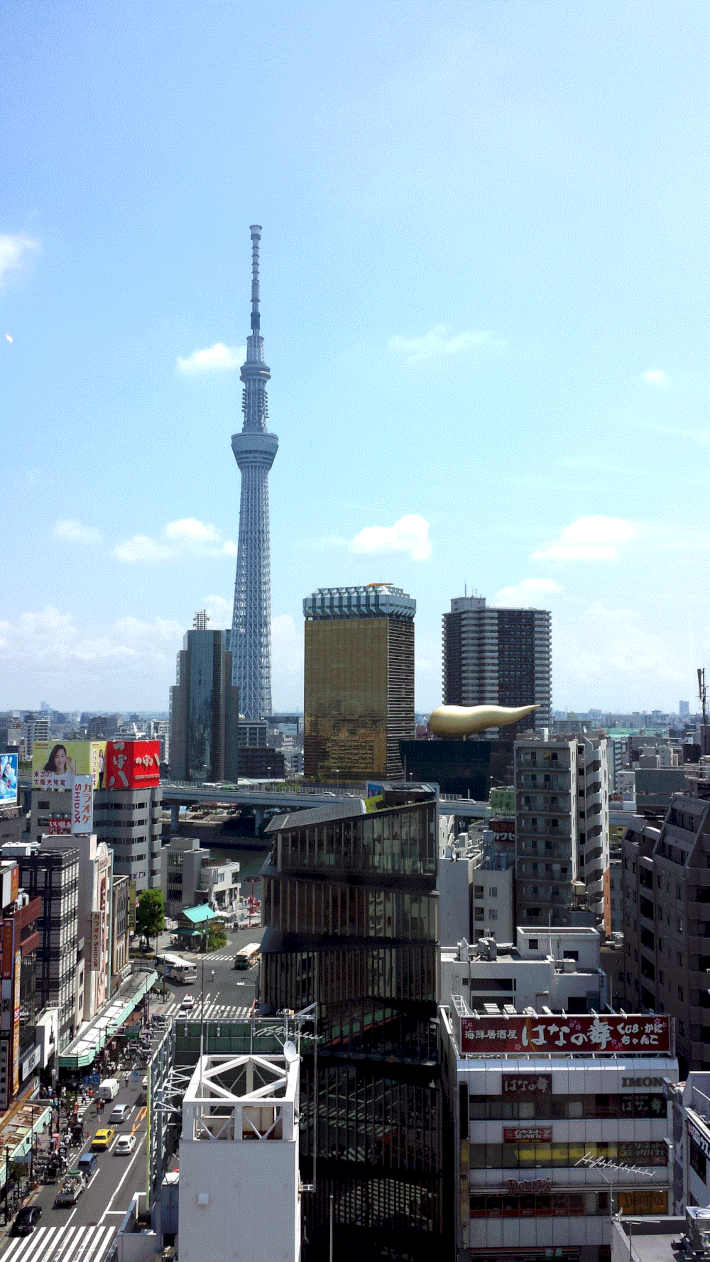
Enoshima Sea Candle
Listen up, suspended monorail fans, here’s another one for you. When most people think of Enoshima, the tidal island near Kamakura, what immediately comes to mind is the picturesque little Enoshima Electric Railway. You’ve probably already seen some liberally-filtered pictures of it, rustic green and beige electric train cars running beside the ocean. But what you hear about more rarely (or see) is the magnificent SUSPENDED MONORAIL that runs from Ōfuna station to Enoshima as well. The Shonan Monorail, as it’s called, is so overflowing with SOUL that it’s practically poisonous to a cynic like me. Their website has a cute little monorail graphic that goes back and forth across the top of the page every so often, infographics and maps explaining that taking the monorail is both 20 minutes faster and 90 yen cheaper than taking the Enoshima Electric Railway, detailed specs about the various monorail models, smiling pictures of the staff, and even information about a children’s book based on the monorail.
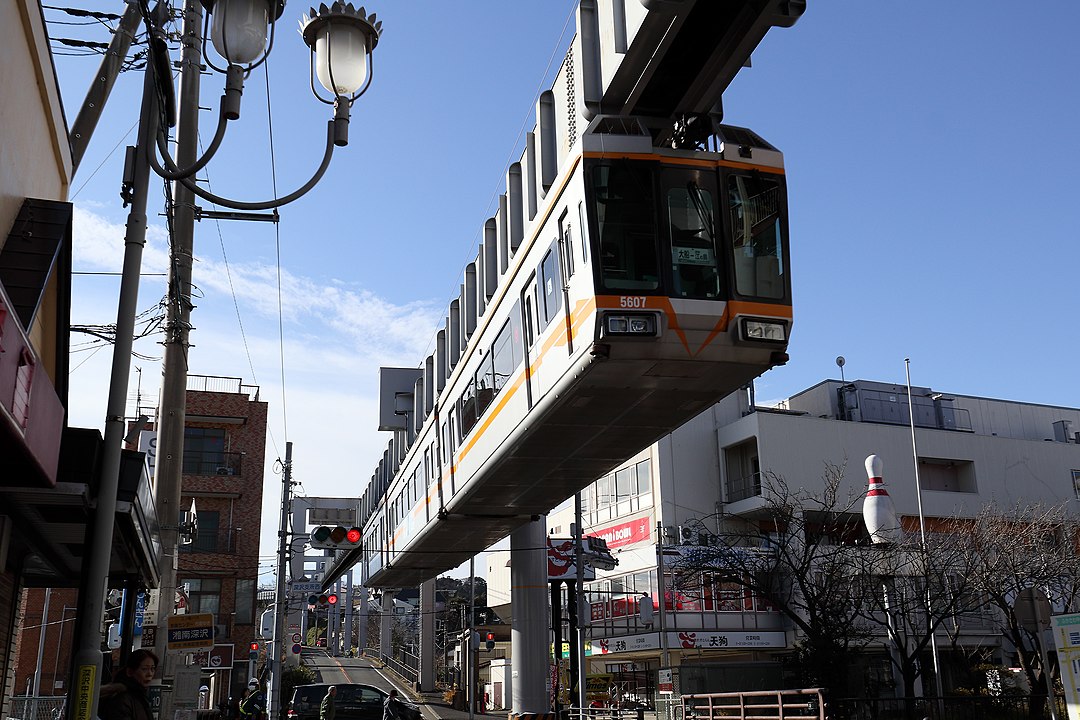
What takes the cake and runs away with it, though, is the WEB MAGAZINE they publish. All of the articles are, to varying extents, inspired by the monorail, but the diversity of the content manages to be unbelievably diverse. Some of it is the sort of stuff you’d expect, like interviews with employees or an impressively long series of posts about the monorail’s history. There’s some series that go a bit deeper, with various experts weighing in on the line’s design details like the station design, signage, or the route maps. There are also quite a few series where artists of various types (writers, illustrators, photographers, game developers, etc.) create works inspired by riding the monorail. Then, there’s the stuff that really goes off the rail, where they bring in various people from the Japanese internet with odd interests and just have them do their thing, riffing off the monorail. For example, they bring in a guy who takes pictures of staircases under the auspices of the “Tokyo Staircase Research Society” and posts them on a blog called “Tokyo Staircase Database”, and he writes a whole series where he tries to find staircases in the area that have the best view of the monorail. Another guy writes about his quest to draw a giant, 2-kilometer goat on GPS by walking around the area, and of course using the monorail line for part of the neck/back. Somehow, he also manages to enlist 20 other people from Twitter to do it with him.
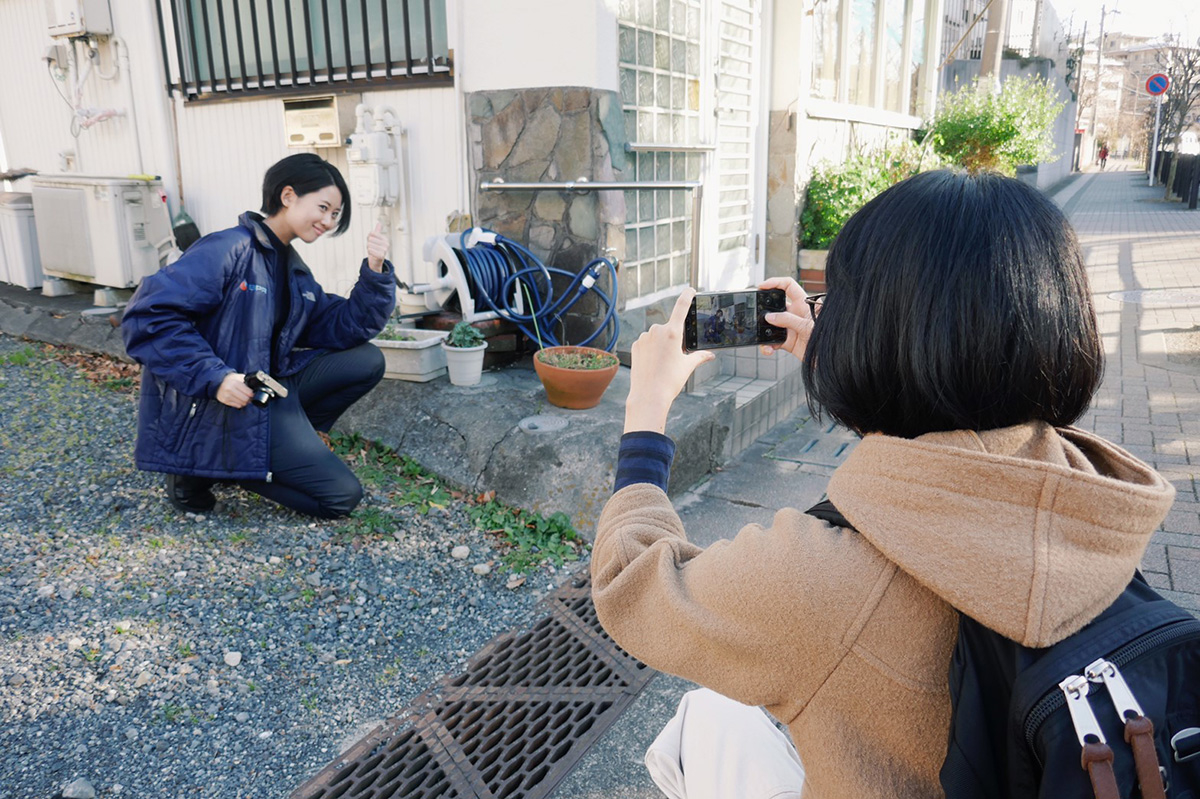
All in all, I must say that the Shonan Monorail web magazine is the very model of corporate artistic patronage. I want to believe in it all so badly, I want it all to be real, but the skeptic in me can’t help but think of the possibility that it’s all marketing, it’s all PR, it’s all fake. After all, the Japanese are notorious for their dedication to keeping up appearances to save face. At the very least, if my enthusiasm for the monorail is genuine, then surely there are others as well... I can’t believe how emotional I am getting over a goddamn suspended monorail line that takes just under 15 minutes to ride from end to end. This is going to end with me having a breakdown riding the monorail someday, wailing “I want to believe...”
The Shonan Monorail is actually the only suspended monorail I’ve ever been on before, a truly transcendent transit experience. The unique viewpoint you get from inside the suspended monorail, of floating just above the city, is not something you can easily experience in person any other way. The route also seems to have been designed by amusement park engineers to deliver gentle turns and a few dramatic curves, which they tout as a big selling point in a lot of the marketing material: “It’s just like a roller coaster”. The best part in my opinion, though, is the tunnels. Yes, the Shonan Monorail is the only suspended monorail in the world that goes through tunnels, and two of them at that. It’s such a dramatic contrast, going from floating in the air one minute to tunnelling through a hill. I couldn’t believe my eyes when I saw that we were about to go into a tunnel, since the thought of it seemed impossible, as the very antithesis of the airiness of a suspended monorail. Then, at the end of the second tunnel, you come out into the air again, arriving at one of Japan’s tallest transit stations. It would have a great view of Enoshima from the terrace, if they hadn’t annoyingly built a bunch of tall residential buildings in the way. The whole ride, though only fifteen minutes long, is exhilarating. I remember seeing the schoolchildren riding the monorail to go home and feeling so envious that they get to ride it every day. Then again, that probably makes it feel commonplace...
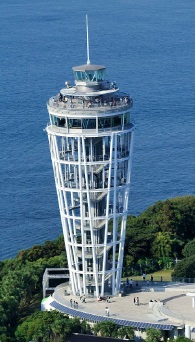
Towers... right.... the Enoshima Sea Candle is on the tidal island of Enoshima, which back in the old days you’d walk across a short sandbar to get to, if the tide was low enough. Nowadays, stability and constant connection is a must, so there’s a pair of bridges, one for cars and one for pedestrians. At the end of the pedestrian bridge, there’s a charming little district of shops and restaurants, of the kind that tends to spring up anywhere in Japan where there’s a walking path to some sort of attraction. From there, the climb up the hill that makes up most of the island begins, shrouded by trees and myriad shrines. It’s a pretty decent hill, I must admit, and one of the traditional shrine-looking buildings on it actually houses a very modern convenience: the only “pay escalator” that I’ve ever seen. At the top of the hill is the Enoshima Sea Candle, which while modest in size, is in fact taller than a couple of the towers in the Tower Association. Many of the other towers are also by the ocean, but the Enoshima Sea Candle is the only one that serves as a lighthouse as well. Hence the “candle” in the name, I suppose. I was unfortunately too cheap to actually go up in the Sea Candle when I visited Enoshima, deciding instead to save my money for the sea caves that lay on the other side of it. Then they ended up being closed due to damage from some typhoon or something, so I guess now I’ve got more than enough reasons to make a return trip.
Ōarai Marine Tower
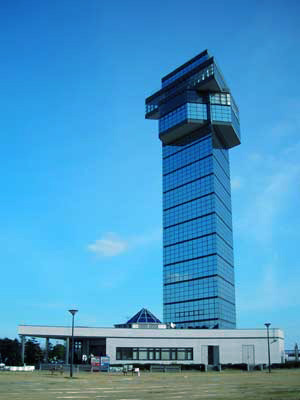
Tower fans watching popular sports anime “Girls und Panzer” were certainly left wondering: is that tower that appears near the port in a few episodes real? In fact, it is: it’s the Ōarai Marine Tower, a shockingly robust tower for the size of the town. The design looks pretty modern, although the observation decks up top remind me of a twisted Rubik’s cube. The only issue with that assessment is that the tower’s footprint is decidedly triangular, though now that I think about it, I’m pretty sure nowadays many puzzle “cubes” are really quite far from being cubic. Won’t be long before we see one that’s a tesseract, I’m sure. Anyways, this tower is certainly pushing the “Near Tokyo” designation as well (despite being a bit further than Choshi, though, the travel time by train is a bit less), but no doubt scores of Garupan fans have made a daytrip pilgrimage to Ōarai. They’ve almost certainly visited the tower, too, since it has a themed café on one of the floors, and it’s not as if there’s a whole lot to do in Ōarai.
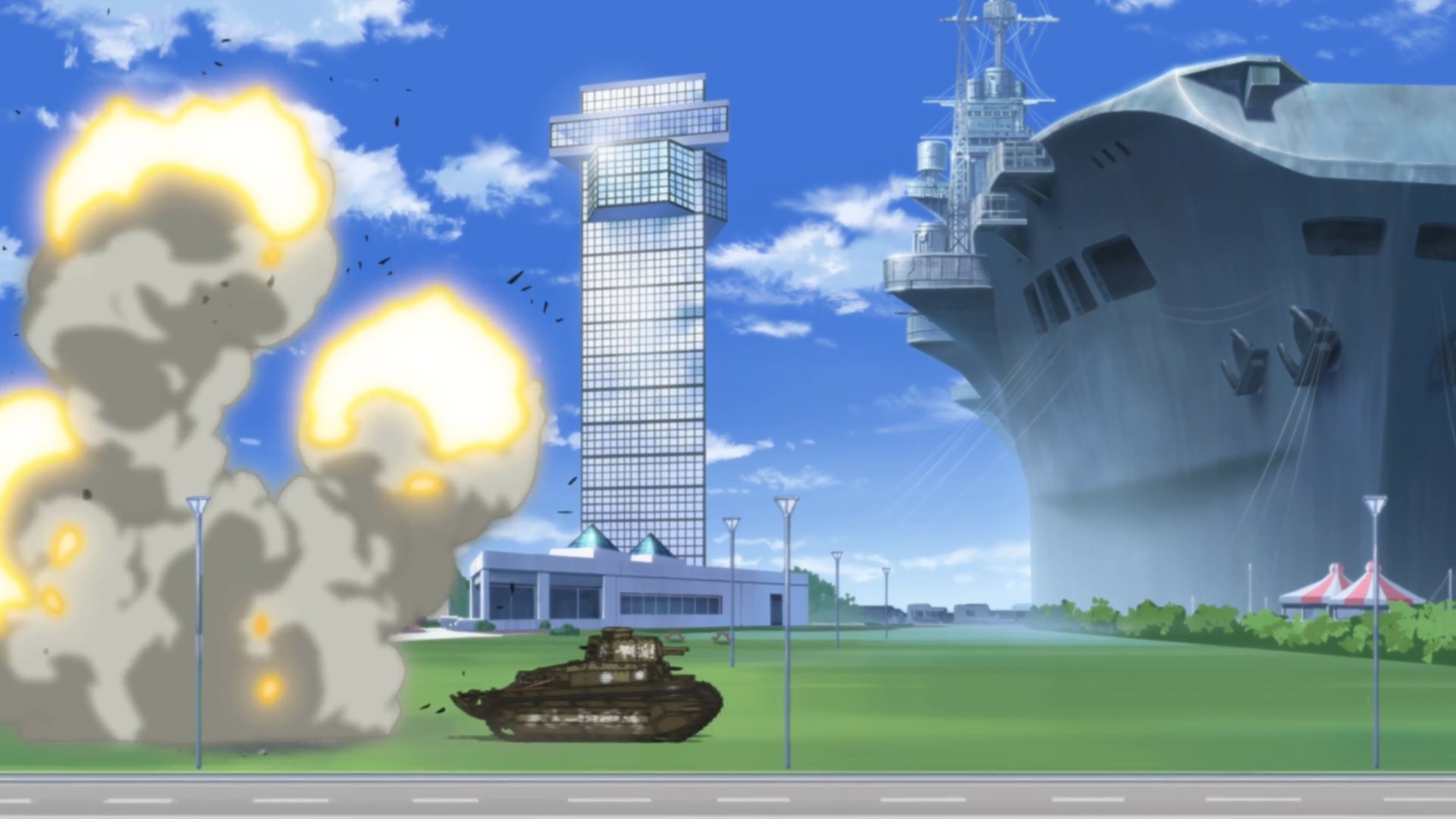
Art Tower Mito
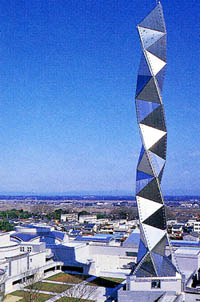
While you’re making your inevitable pilgrimage to Ōarai Marine Tower, you will almost certainly have to transfer trains in the nearby bigger city of Mito. As it so happens, there is a tower in Mito as well, and it happens to be one of the most unique in the country. Many towers are built for tourism, quite a few are built for various broadcasting purposes, but the tower in Mito stands apart as a tower built for art (and also tourism). Hence the name “Art Tower Mito”, to ensure that you understand that the tower was not built to lure sightseers, it just happens to do so as a result of being so artistic. I would say that it’s the only tower design I’ve seen so far that could work just as well as an Ikea lamp, which says a lot. The tower also reminds me of the day in third grade when they had us cut out a bunch of paper triangles and try to tape them together into polyhedra. Sometimes the only way to move forward is by going back, I suppose.
The tower itself is the centerpiece of a whole contemporary arts venue for the area, which as a whole seems to be confusingly called “Art Tower Mito”, at least in the English translation. The design of the whole complex is no less eccentric, and some might even say artistic. It’s the absolute pinnacle of eighties/nineties postmodern architecture mixed with Japanese Metabolist influences, from the era just before glass took over all modern architecture. I went on Wikipedia and checked the “Postmodern Architecture” page just to make sure I wasn’t completely talking out of my ass with that one (I am in no way trained in architecture), and what should I see scrolling down the page but a picture of Art Tower Mito in all its glory in the Japan section. I don’t know what else to say about the design of the complex other than it looks like the sort of place where they’d film an episode of Stargate SG-1 set in a city on another planet. Highlights include the fountain that’s mostly just a giant rock suspended a few inches off the ground by cables, and yet another attempt at artificially replicating the accidental success of the Leaning Tower by pedestal the tower sits on at such an angle that it appears it has partially sunk into the ground. The tower itself is probably the least postmodern element of the whole complex, as it looks just a little too raw and industrial. It looks like it might be too thin to actually go up in, but there’s actually enough space within for an elevator, and if you look closely at the top of the tower, you can see the portholes (of course) that are the windows for the observation deck. Unfortunately, the dedication to the schtick comes at the expense of the view, according to reviewers. Oh, the sacrifices we make for art.
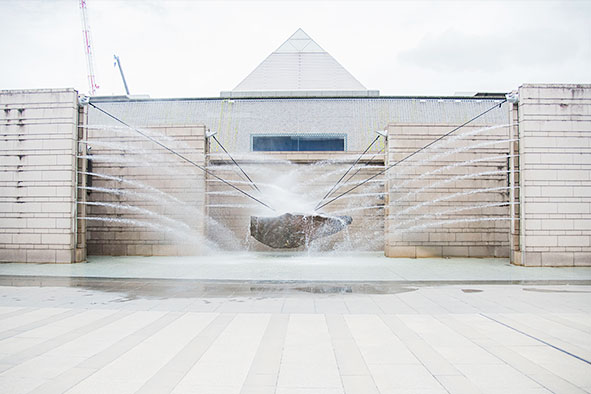
The Rail Trip
Day 5
Alright, enough time messing around with towers that don’t even count around Tokyo; it’s time to hit the rails. If the trip is going to be ending in Osaka, then it makes the most sense to start off by riding up and visiting the towers in Hokkaido. The remoteness means that there will be lots of long train trips and not a lot of towers punctuating them, so putting the towers up there at the start of the rail trip, before any train fatigue has set in, is also a good idea. Unfortunately, it seems that the Tohoku region has really been slacking in the tower department, as there’s not a single tower in the Stamp Rally between Tokyo and Hokkaido. I conducted some cursory research, and seems that the reason for this is that there just aren’t any towers in Tohoku. The closest thing seems to be the triangle building in Aomori (look up Aomori triangle, you won’t regret it), a very modest (in height, not form) skyscraper with an observatory near the top. There’s also a little TV tower in Utsunomiya, but that’s so close to Tokyo that it barely counts. So, there aren’t any necessary stops between Tokyo and Hokkaido for the Stamp Rally, and thanks to our soon-to-be good friend, the Shinkansen, the imposing distance between Tokyo and Hakodate can be covered in a mere four hours, which means that the trip can easily start off with a straight shot up to Hokkaido. The most notable part of the ride is the particularly long tunnel under the ocean near the end, right before you arrive at the Hokkaido Shinkansen’s current terminus at Shin-Hakodate-Hokuto. From there, it’s a short hop on the local train over to the actual city of Hakodate, where the first tower of the rail trip awaits, a mile and a half away from a JR station of the same name.
Goryōkaku Tower
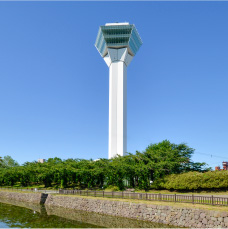
Some towers are built to be landmarks, and others are merely built near landmarks. Goryōkaku Tower is one of the latter, casting its shadow upon and taking its name from Hakodate’s most famous landmark, the Goryōkaku star fort (the official English translation on the Tower Association’s website uses the much more ominous term “pentagram castle”). This is actually one of the towers I’ve been to before, and it may have been while looking around for a bathroom in the so-called “atrium” that I first found out about the Stamp Rally. Actually going up in the tower was a bit pricy, though, so instead I then strolled around inside the fort itself, which was free.
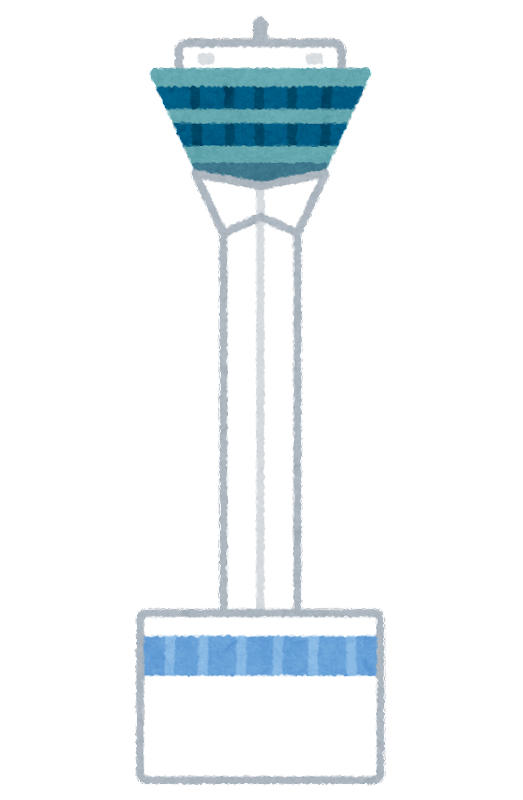
The tower may just seem like another way of depriving tourists of their money at an attraction, but in fact, having an observation tower makes some sense, as otherwise there’s no way to really appreciate the full star-shape of the fort (other than Google Maps). As a nod to the fortress, the observation deck at the top of the tower is pentagon-shaped as well, although other than that it really doesn’t really match the fort at all. To me, it looks like it would fit in really well at an airport, as the control tower of course. The tower overall looks very slick and new, and that’s because it is in fact the newest tower in the Association, having been completed in 2006. As a result, I was extremely confused when I went on their website, and saw that the tower history went back to 1964. It turns out that the current tower was actually the second tower built on the site, which is something you don’t see very often. Towers in Japan tend to either became famous landmarks on their own and so end up being maintained in their original state, or they fall off in popularity and get demolished without being replaced once they get too shabby. The Goryōkaku Tower, through its ties to the fort, seems to have avoided both fates by not becoming a landmark on its own (the old tower’s design was pretty unremarkable), but remaining popular enough to justify a complete rebuild. The most interesting thing about the replacement is that they didn’t actually demolish the old tower until the new tower was completely finished, so for a brief time, you could see the rare sight of two towers side by side in Hakodate.
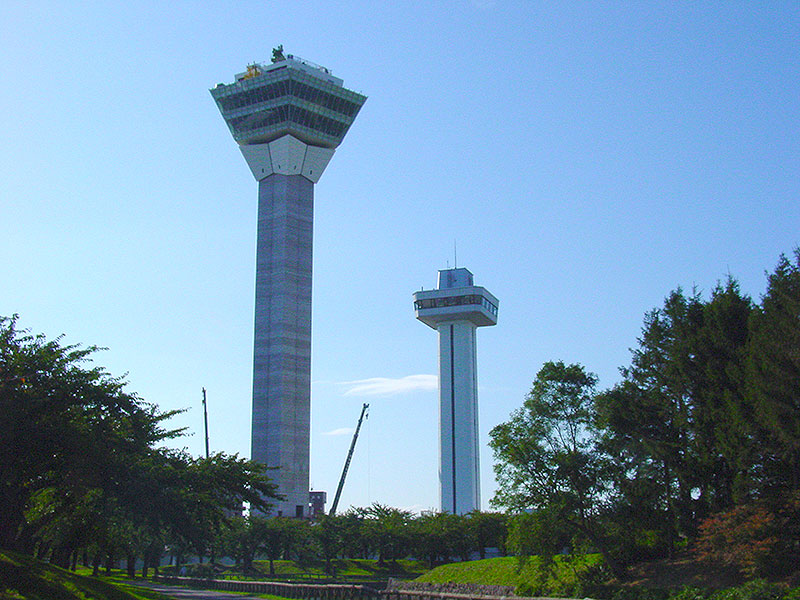
Day 6
Shin-Hakodate-Hokuto is the end of the line for the Shinkansen in Hokkaido, so despite Hakodate and Sapporo being far closer to each other than Tokyo is to Hakodate, it actually takes nearly the same amount of time (3.5 hrs) to get from Hakodate to Sapporo, where the next tower stands waiting. Even so, slower trains would probably still have been able to do good time, if the rail lines weren’t forced by the mountains to follow circuitous paths, hugging meandering valleys and the curvaceous coast.
Sapporo TV Tower
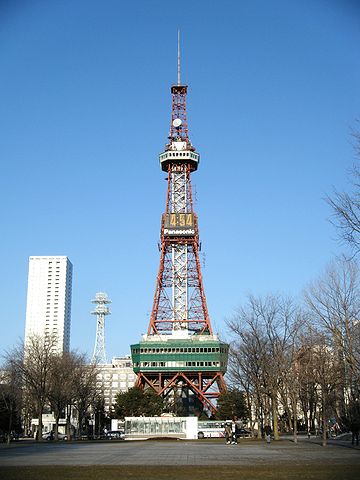
A distant and much shorter cousin (or perhaps sibling) of Tokyo Tower, the Sapporo TV Tower is conveniently located only a few blocks away from Sapporo’s main station. The resemblance to Tokyo Tower is no coincidence, as Sapporo TV Tower was also designed by Tachū Naitō, whom I previous deemed the Japan Tower Design King. Now we’re starting to see why, and don’t worry, this certainly isn’t the last time he’ll show up. From looking at pictures, though, it looks like the tower’s most distinctive feature is something Naitō didn’t have a hand in at all: the giant digital clock (right above a Panasonic logo, love these tower sponsorships), which I’m sure was absolutely cutting-edge and futuristic back in the day, but now seems rather quaint.
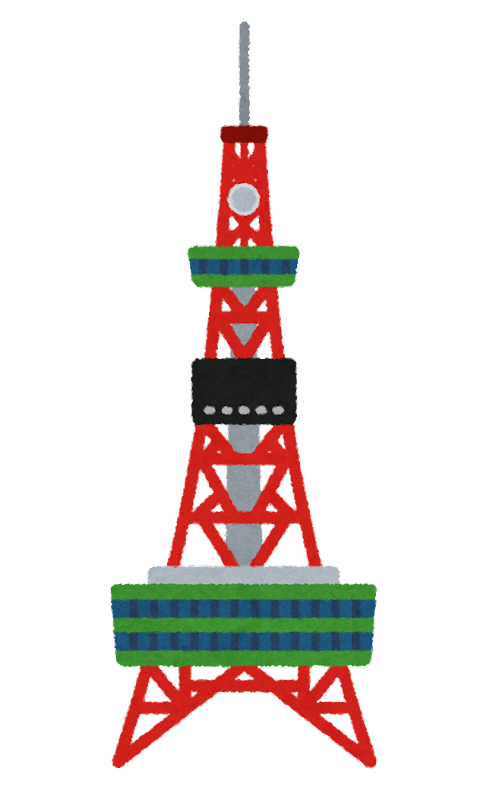
Sapporo TV Tower also has one of the most popular mascot characters among all the towers, テレビ父さん (TV Father? TV Dad? TV Daddy?). There’s a strange insistence that he’s an “unofficial” mascot/character for the TV Tower, and yet he’s plastered all over the tower’s website, merchandise, the tower itself, and so on. I went through a lot of trouble trying to find the “official” character on the tower’s website and had no luck, whereas TV Dad gets an entire section of the official website (incidentally, his page has some fascinating web design, just keep scrolling down. I hesitate to call it good, but there’s certainly something there). Even Wikipedia goes so far as to note that despite being referred to as an unofficial character, he’s used like an official one. I was still curious about the official character so conducted some further research, and eventually found someone on another website talking about it. He also notes the fact that the whole Sapporo TV Tower (tickets, pamphlets, website, merchandise) is steeped in TV Dad, and yet they go out of their way to insist he’s an unofficial character. Eventually, after asking the shop staff in the TV Dad shop, he finds two pieces of merch with the Sapporo TV tower’s official character, “Tawakki”, hidden in a corner of the store. The final verdict from him is that while neither Tawakki nor TV Dad are particularly cute, TV Dad definitely wins due to the strength of his impact. I guess the Sapporo TV Tower staff know this too, but would feel too guilty killing off Tawakki for good, so now Tawakki is Sapporo TV Tower’s deformed basement child. Who knew that towers had such skeletons in their closets...
Day 7/8
After a night in Sapporo, the long trip down south to the next towers begins. Finally, we are forced to break the one tower per day streak that you may or may not have noticed has been going on so far, as it would take a minimum of ten straight hours on the train to get to the next closest tower from Sapporo. Sure, it could be done if you’re going for a speed record, however as I said before, it’s not going to be that kind of trip, which is why I’ve budgeted two tower-free days (a kind of tower weekend) to get from Sapporo back down to the general vicinity of Tokyo, where things will pick back up. In the absence of any required tower visits, this is the most unstructured part of the whole itinerary, and there are several different options for stops on the way back down. The final plan will probably end up being decided on the spot based off of the general vibe, but I’ll lay out a few of the options here as well.
Going from Sapporo to just Hakodate already takes almost four hours, so stopping there again, perhaps seeing Mt. Hakodate or something, would be completely understandable. From looking at a map you might never guess it, but in terms of travel time, Hakodate is essentially the half-way point between Tokyo and Sapporo. Another option would be to go a little further and visit Aomori in all its triangular glory (frankly I’m not sure what else is there, but since the triangle building seems to be a tourism information center, stopping there could certainly help), or really go the distance and head all the way down to Sendai and spend two nights there, using the intervening day to go out to Yamagata or something. Between Aomori and Sendai, there’s even Morioka or Hachinohe as well. I think no matter what, though, the second night should be in Sendai, so the real question is where to go for the first night: Hakodate, Aomori, Morioka, or Hachinohe. As I said, I’ll probably leave that decision until the actual trip.
Day 9
If you look at the whole tower map, there’s one clear outlier that’s certain to provide a challenge: the somewhat-whimsically named Yumeminato Tower. There are no other towers within a several hundred-kilometer radius, like it’s putting out some kind of AT (Absolute Tower) field. The two towers in Hokkaido may be clustered together farther away from the next nearest towers, but at the very least they have each other up there. The main reason for the remoteness (in terms of towers at least) of Yumeminato Tower, supernatural explanations aside, is because it’s also just in a remote area. The tower is in Tottori prefecture, apparently the least populous in the country, on the Sea of Japan side of Chūgoku. There are no major cities nearby, and of course no Shinkansen. You may be wondering why I’m even mentioning it right now when we’re supposed to be near Tokyo again, since it’s farther away from the Tokyo area than almost all of the other unvisited towers. This is because while researching transportation options to Yumeminato Tower (many of which involve lengthy trips from Okayama, the closest big city connected to the Shinkansen), I made an extraordinary discovery. One half of Japan’s last remaining overnight express train service, the Sunrise Izumo, departs from Tokyo and splits off in Okayama to go off towards Tottori, stopping at Yonago, within spitting distance of Yumeminato tower.
For a train enthusiast, it’s simply too good to pass up. Many would live on a train if given a chance, and travelling in a sleeping car is almost as close as you can get. Plus, this would not be just any overnight train, it would be a JAPANESE one, with the legendary standard of service that comes with it. Alas, the rise of the Shinkansen, which is still extremely fun and cool, pretty much killed off all of Japan’s overnight trains. Now if you want to take an overnight train, you either have to take it just for its own sake, or have some legitimate reason for visiting the far reaches of Tottori. Thanks to the Stamp Rally, I find myself with both motivations. As if things couldn’t get any better, the most barebones accommodation on the sleeping train, the Nobinobi open-plan sleeping area, is included with the Japan Rail Pass! Surely, it must be destiny. The one caveat is that the Nobinobi spots seem to be pretty popular so an advance reservation is highly recommended, but it is only possible to get a reservation after the Pass is already active, so it would only be possible to make a reservation only about a week ahead on this itinerary. If they are all sold out, though, I think this is one situation in which I’d be willing to shell out some extra cash and get an actual compartment. After all, it’s a unique experience and it would be a pain to change the itinerary, especially since this train fits it so well.
Day 10
The Sunrise Izumo arrives at Yonago at around nine in the morning, a comfortable wake-up time for me, and from there it’s only a brief ride to the station closest to the tower, Takamatsucho. Fortunately, the tower opens at nine, so it’s possible to go directly there without wasting any time. The ability to get everything done early is much welcomed, since spending a night in the area would be difficult, as I see absolutely no hostels anywhere nearby on Hostelworld. Obviously hostels aren’t the only option, and not every hostel in the world shows up on Hostelworld, but still, it is quite far out there. This means that in the same day, after visiting the tower, a 3-hour minimum train ride to get back to civilization will be required, which is good to get a start on early.
After leaving the tiny, delightfully rural unmanned train station of Takamatsucho and passing through the sort of small-town, semi-rural neighborhood that often induces that kind of unfounded nostalgia you can get even while going to certain places for the first time, you end up at the foot of a long, peculiar park that I am nearly positive was the grounds for the expo in the late nineties that Yumeminato Tower was built for. Looking at it on Google Maps, it seems that they haven’t made much of an effort to maintain the park, and it’s beginning to look rather overgrown and nearly straight-up abandoned. The vibe there is even odder thanks to the original design of the expo grounds, which followed all sorts of outdated design fads that now feel alien, doubly so as they slowly decay. You can only see it from above, but the whole thing is centered around a long, slightly askew, three-wide strip of big black and white tiles, that reminds me of a crossword puzzle. At a few points, it’s interrupted by intruding bean-shaped sections of grass or pavement that mostly seem to be shaped like beans. The weirdest thing is that across the whole length of the crossword strip, there is a series of strange concrete monoliths with various silhouettes cut into them, a design flourish of the sort that I suppose was in fashion at the time. It seriously looks like the former expo park alone could have been the inspiration for half the works of tkmiz.
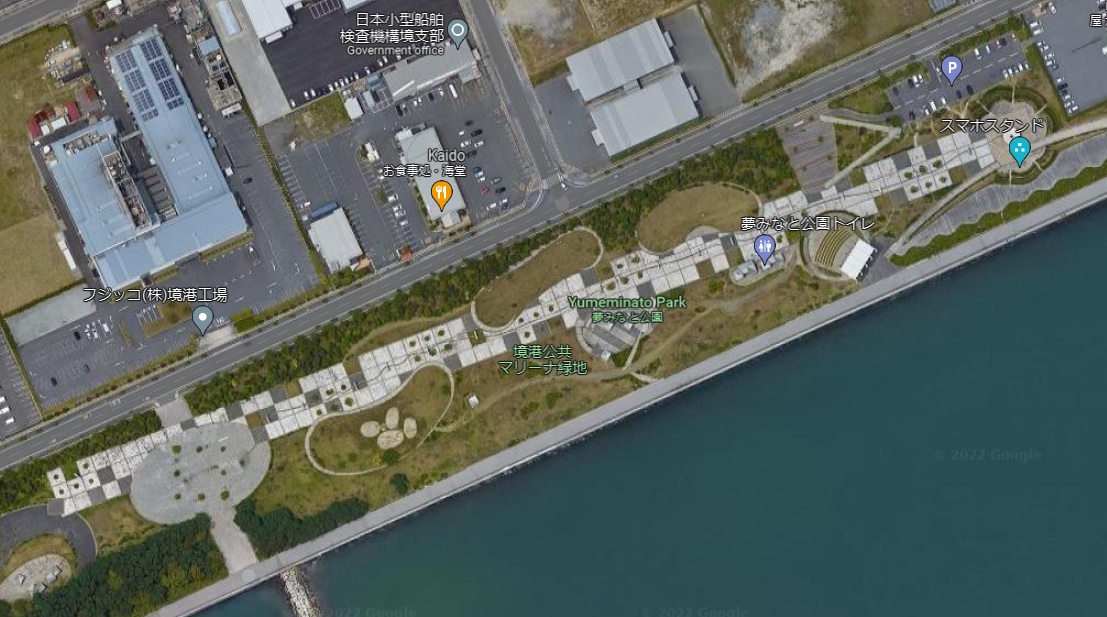
Yumeminato Tower
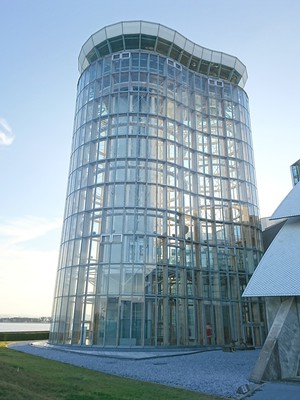
The tower drought ends at last. At the end of the park, humble Yumeminato Tower comes into sight (I assume). Humble, because it has the dubious distinction of being the shortest tower in the All-Japan Tower Association, at only 43 meters high. It just barely sticks out from the odd circular building below it, which appears to be some sort of museum. The building could be described in many ways. Is it an observatory, UFO, the discarded pauldron of a giant, or perhaps some sort of undiscovered giant mollusk? I swear it even looks like it has a face. Behind its protective shell building, the tower itself seems like it might be a modest, low-rise office building. Only the fact that the inside is clearly mostly empty air and the unusual avocado-shaped footprint give away the game. Overall, it seems to me like it’s going to be one of those “it’s the journey, not the destination” situations. Somehow, though, it’s almost poetic that the shortest tower requires the longest travel time.
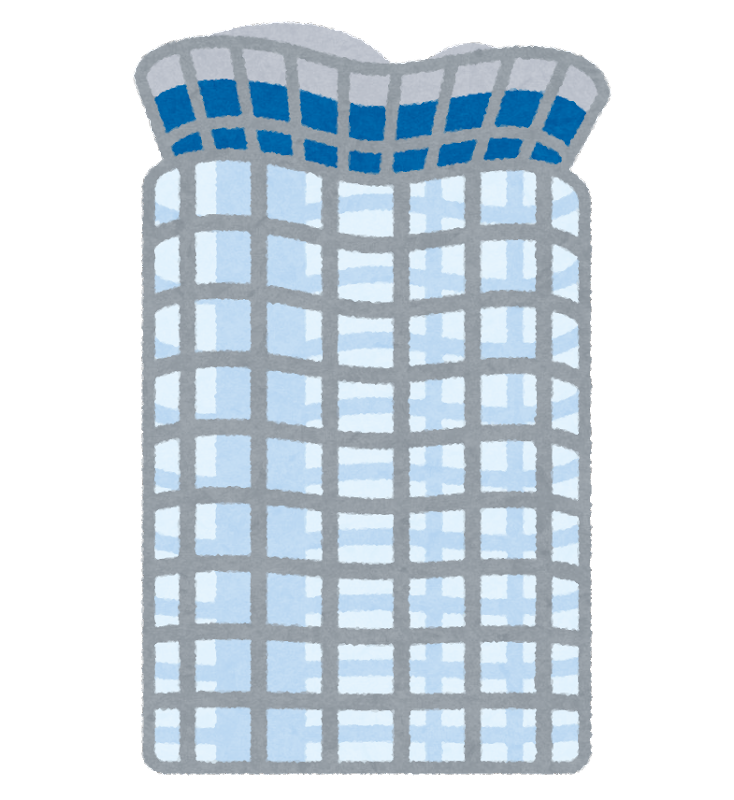
There are unvisited towers in either direction from Yumeminato Tower, but I think the best option is to continue heading down south and make for the three towers in/near Kyushu. The fastest route would be to go back the same route the Sunrise Izumo just took, towards Okayama and the Shinkansen, though when possible, I prefer to keep things fresh and try something new. Instead, you can go back to Yonago and take the limited express Super Oki on Sanin Main line down the upper coast, which then heads towards the interior and meets the Shinkansen down south, near Yamaguchi. It’s one of the longest trips on a limited express train you can take, through a remote and seldom-seen part of Japan, and I have never heard anyone even mention that area or the train ride, but I have absolutely no doubt that it will be quite scenic.
From Shin-Yamaguchi, it’s a comparatively quick ride on the Shinkansen down to Kyushu’s largest city, Fukuoka, where the main train station is confusingly named “Hakata” (for historical reasons, I guess). All of the modern amenities can be found in Fukuoka, like cheap hostels and you guessed it, another tower in the Stamp Rally. It’s probably a bit late by this point, though, so the tower can wait until the next day.
Day 11
Ah, Day 11, the halfway point. Somehow it feels like it’s way further. Maybe I’m too long winded. Maybe it’s because I threw in 4 (so far...) extra towers earlier. Those are both basically the same thing, now that I think about it. Anyways, after spending the night, it’s off to the next tower, which is good to visit on a fresh new day as it’s rather inconvenient to get to. Unfortunately, JR lines stop just short of the area, so you have to pony up a few yen and ride the Fukuoka city subway to Nishijin station, the closest rail transit station to the tower. You’ll never guess its name.
Fukuoka Tower

Fukuoka Tower is one of the more recent towers, evidenced by the fact that it’s cloaked in smooth, shiny glass so that at first glance it appears to be an emaciated modern skyscraper. Back in the day, observation towers were clearly distinguishable from skyscrapers by laying bare their metallic skeletons, as if to tell us “Look here, no salarymen or offices to be found”. The architects of the Fukuoka Tower, however, blur the lines, and show us that when you ignore the interior, observation towers and skyscrapers are really quite similar, in that they are both tall buildings. Of course, I am sure that they weren’t intending any message of that sort at all. Instead, at some point I guess tower architects had copied the Eiffel Tower so many times that it became uncool, so they had to move on to copying something else, namely modern skyscrapers. Our old friends Chiba Port Tower and Oorai Marine Tower are along the same lines and were even built around the same time,  although Fukuoka Tower does manage to distinguish itself among them by being particularly tall, the second-tallest in the Tower Association, trailing Tokyo Tower by about a hundred meters. But, some things about tower design never change: Fukuoka Tower’s true form as an observation/broadcasting tower is betrayed by a familiar orange-and-white wireframe pinnacle at the top, bearing all sorts of antennas, dishes, and catwalks. It’s as if they gave up on the modern skyscraper design ¾ of the way through and just decided to graft the top part of Tokyo Tower to it.
although Fukuoka Tower does manage to distinguish itself among them by being particularly tall, the second-tallest in the Tower Association, trailing Tokyo Tower by about a hundred meters. But, some things about tower design never change: Fukuoka Tower’s true form as an observation/broadcasting tower is betrayed by a familiar orange-and-white wireframe pinnacle at the top, bearing all sorts of antennas, dishes, and catwalks. It’s as if they gave up on the modern skyscraper design ¾ of the way through and just decided to graft the top part of Tokyo Tower to it.
After getting Fukuoka Tower out of the way nice and early, it’s time to settle in for a rail trip to Beppu, on the opposite coast of Kyushu. It’s faster to take the coastal route, but at this point we’ve got plenty of time, so we’ll save that for later and take the scenic route, through the country (though I’m sure the coastal route is scenic as well). With luck, the train will be the special “Yufuin no Mori” train, which I saw in a picture billed as a “European Classical Express” on the packaging for a pair of chopsticks that comes with a classic European meal of raw fish and miscellaneous pickled root vegetables that they serve on the train. What this means for the train cars, though, is wood floors, fancy little curtains, and seats that look like easy chairs. Just like Grandpa’s house.
Day 12
Beppu, a city I already thought that I must return to. Not because of what I saw there, but because of what I didn’t see. Specifically, the famous Eight Hells of Beppu, a diverse set of beautiful (though dangerously hot) hot springs around the town. They are probably called “Hells” for the same reason that the volcanic valleys scattered across Japan are called “Hell Valleys”. For those not familiar, back in old timey-times, when Buddhism was making its way across Japan, the Buddhist monks had difficulty convincing the masses to follow Buddhism, as there were too many difficult and rather abstract philosophical concepts involved. I have some experience with this, and can relate, because for some reason in high school, the teacher for an amorphous philosophy/religion class I had to take was a full-on Zen Buddhist monk, despite quite clearly being of Irish descent. He had a shaved head, wore monk robes all day while teaching, the full kaboodle. He may have retired the next year because of me, but I’m probably giving myself too much credit. In any case, it seems one of the main difficulties the Buddhists had was convincing people that “Nirvana” was actually a desirable goal. As far as I can tell, it seems to be some sort of non-existence or elimination of self or suffering or something. Go ahead and read the Wikipedia page for “Nirvana” and see if you could explain it to a friend, let alone an ancient Japanese peasant. In any case, the pragmatic Japanese monks figured that there was no harm in a bit of subterfuge as long as it was towards a good end, and made up a rich folklore of stories about those not following the teachings of Buddhism turning hungry ghosts with distended bodies wandering and eating feces and whatnot. Another part of the mythos was a hellish realm that people would be condemned to, and when asked what it was like, the volcanic valleys across Japan, with their barren landscapes, ominous steaming, and sulfuric odor provided an excellent physical model for the monks. Thus the name “hell valley”. I’m reasonably sure all of this is accurate, but I am writing this all up on the spot from vague recollections of classes so it’s possible that all of this is just the fanciful result of a bunch of wires getting crossed in my head.
So, I have been to Beppu before, to see some or all of the hells, and due to poor planning, spectacularly failed and saw none of them. Luckily, there’s a tower in Beppu, so now I have a chance to redeem myself. Then again, I feel like the main goal of the visit being the tower means there’s an even higher chance of having to skip seeing the Hells. The chances of missing the hells seem even higher when I consult the map, and see that the tower is only a few blocks from the main station, whereas all of the hells are so far away that some sort of bus is almost certainly going to have to come into play. I have tried to skew the odds in favor of seeing both by staying the night and all, but we’ll see.
Beppu Tower
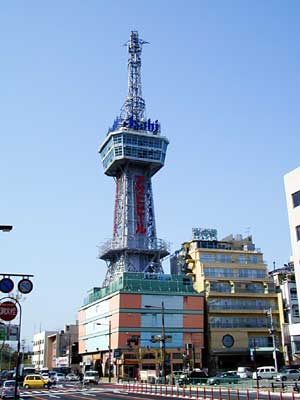
It seems that last time I was in Beppu, the place I stayed was only one block away from Beppu Tower, and yet it didn’t seem to have registered in my memory at all. I’m frankly wondering if I even saw it. Yes, it is one of the shortest towers in the Rally (somehow, still twice the height of Yumeminato Tower), but it’s also decked out in massive neon advertisements for Asahi beer in a kind of Osaka vibe. Does this say more about the tower or my memory, I wonder. In any case, Beppu Tower’s design is probably looking quite familiar at this point, and it’s no coincidence as it’s Tower Design King Tachū striking again. Out of his works, Beppu Tower is certainly the least appreciated, most likely because it’s his shortest and furthest-out. 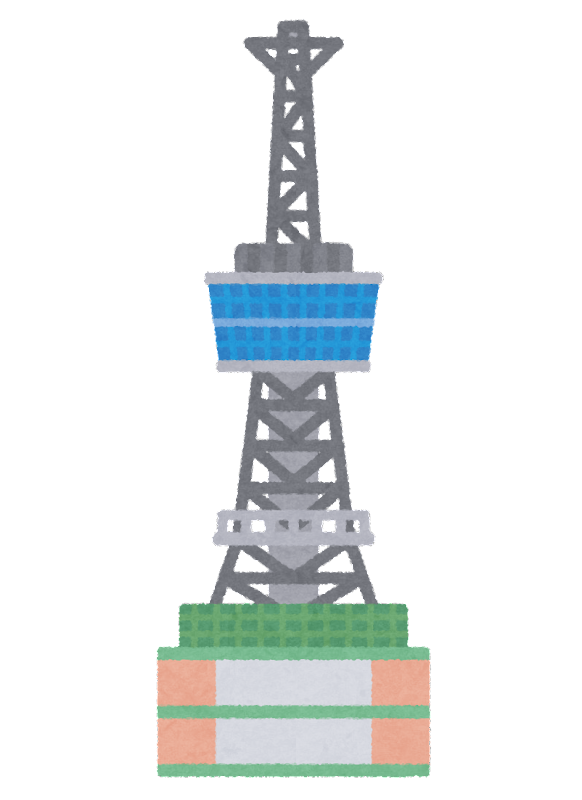 As a result, it has a distinct shabby and neglected atmosphere that you don’t see around his other towers, though their designs may be equally out of fashion now. There’s also the fact that it looks like it’s just growing out of a random building, which possibly contributed to me either not noticing it or not remembering it as something special. I do have to wonder why Beppu of all places, as all of his other towers (including some we have yet to see) are near the centers of Japan’s largest and most prominent cities.
As a result, it has a distinct shabby and neglected atmosphere that you don’t see around his other towers, though their designs may be equally out of fashion now. There’s also the fact that it looks like it’s just growing out of a random building, which possibly contributed to me either not noticing it or not remembering it as something special. I do have to wonder why Beppu of all places, as all of his other towers (including some we have yet to see) are near the centers of Japan’s largest and most prominent cities.

Unfortunately for my hell-visiting odds, there’s not much more time to dally in far-flung Beppu, because time is running out and there are still towers to visit back up north. In fact, we passed by and missed a tower right near the entrance (if one can call it that) of Kyushu, during the beeline to Fukuoka. It’s tantalizing close to being in Kyushu, but is in fact just on the other side of the bridge, in the city of Shimonoseki, at the very tip of Honshu. From Beppu, it only takes a relatively-straightforward train ride along Kyushu’s potentially-scenic northern coast (I do not feel that optimistic about this one, for some reason. Coast fatigue?) which we previously avoided in favor of the slower land route. As a result, today we will attempt something daring and unprecedented: two towers in one day.
Kaikyo Yume Tower
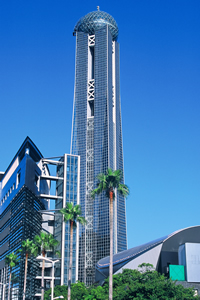
Kaikyo Yume Tower is another modern glass skyscraper tower, but it pretends to no other function like television broadcasting. At the top, there’s simply a big glass ball, the “first of its kind in the world” apparently. It broadcasts only the immense wealth and power of Yamaguchi prefecture, which seems to have backed its construction. I’m sure the citizens of Kitakyushu are apoplectic every time they gaze across the strait and see the tower there, challenging them. Unfortunately, in Fukuoka prefecture, they decided to build their tower over in Fukuoka. Even though it’s taller, who can tell? They wisely built Kaikyo Yume Tower in an area with no other tall buildings, so it appears more prominent than Fukuoka Tower. And also, of course, Kaikyo Yume Tower has a cool glass ball instead of a rather ill-fitting and frankly cliché pointy radio mast. The ball (or perhaps orb) does, for some reason, feel a little bit ominous. 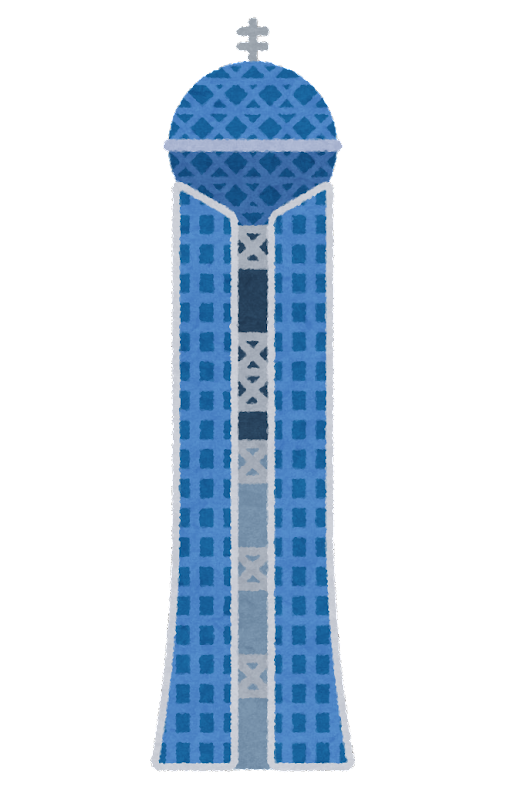 Is it because in our collective cultural consciousness, crystal orbs are often imbued with dark powers? Or is it because I’m afraid it might roll off and crush something? Maybe they should have impaled it on a radio mast instead. Anyways, in a kind of reverse-crystal ball situation, Kaikyo Yume Tower advertises its observation deck in the sphere as “360°Sky View”, which I’m surprised they didn’t try to bill as something more ambitious and less based in geometric fact such as 3600°or something, seeing as it is a sphere and not just a mere circle. Then again, who am I to complain about truth in advertising?
Is it because in our collective cultural consciousness, crystal orbs are often imbued with dark powers? Or is it because I’m afraid it might roll off and crush something? Maybe they should have impaled it on a radio mast instead. Anyways, in a kind of reverse-crystal ball situation, Kaikyo Yume Tower advertises its observation deck in the sphere as “360°Sky View”, which I’m surprised they didn’t try to bill as something more ambitious and less based in geometric fact such as 3600°or something, seeing as it is a sphere and not just a mere circle. Then again, who am I to complain about truth in advertising?
Day 13
Getting back on the Shinkansen after the brief sojourn in Kyushu, it’s a quick trip back up the inner coast, past Osaka/Kyoto (we’ll get the towers around there later), and towards Nagoya. Two of the towers in the general Nagoya area are easy to handle, since they’re both in the city and quite close to each other, but the third is rather far away, in a city that I imagine is the Japanese equivalent of Rockford, Illinois. However, as it so happens, there’s a both a Shinkansen stop and a hostel in the nearby city of Gifu-Hashima, which makes it possible to stop by while going up to the towers north of Nagoya, before making an actual visit to Nagoya later on. After making the arrangements for accommodation at the hostel and dropping off baggage, the local train/bus can take us over to the next tower.
Twin Arch 138
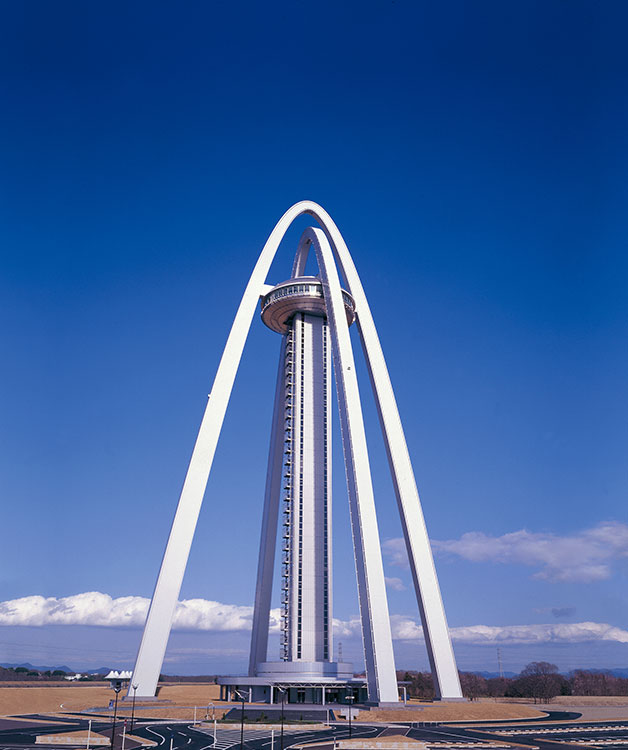
Every tower is unique, but some are more unique than others. I would say Twin Arch 138 is the most unique tower in the entire Association, and you can probably see why. They say that it is the first arch-type tower in Japan, and as far I know, they haven’t built any other ones since. The only vaguely similar tower I can think of is Global Tower, which doesn’t quite make it to a full arch. Drop the “h” to represent that deficiency and call it an arc-type tower, I say. Anyway, as you may have guessed, the “138” indicates the height of the tower, which they derived from the city name (Ichinomiya) using classic Japanese gematria techniques. They're lucky that the town name wasn’t something that would yield an overly-ambitious tower height, like “Hachinomiya”. The actual height, though, is still enough for them to claim that it’s the tallest of its type in the East. I’m not sure what taller arch-type tower we have in the West. 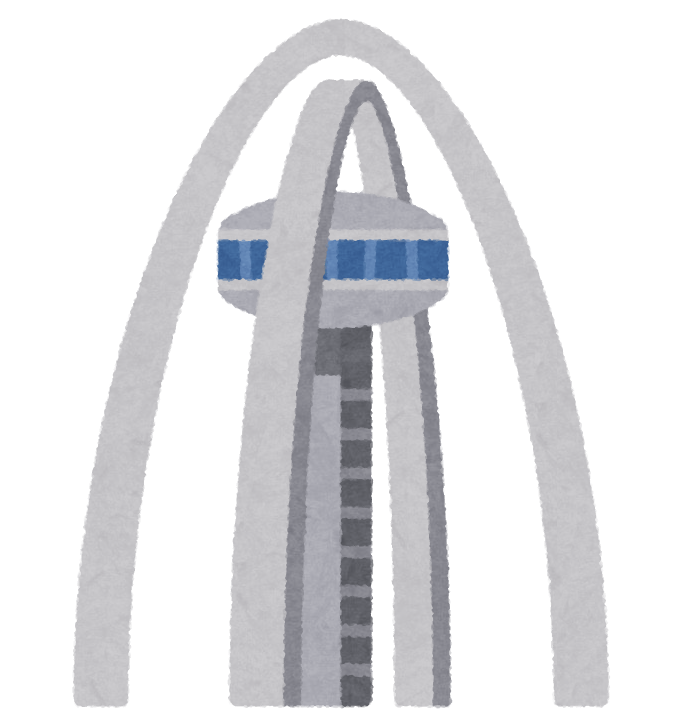 All I can think of is the St. Louis Gateway Arch (of course), which is in fact taller, but it doesn’t have any definitive tower component like Twin Arch 138. But, scrolling the list of tallest towers on Wikipedia, at a comfortable distance above Twin Arch 138, there it is: the Gateway Arch, 192m. Apparently, in the park around the tower, there’s also a 1:20 scale reproduction of the Gateway Arch. I guess that settles it.
All I can think of is the St. Louis Gateway Arch (of course), which is in fact taller, but it doesn’t have any definitive tower component like Twin Arch 138. But, scrolling the list of tallest towers on Wikipedia, at a comfortable distance above Twin Arch 138, there it is: the Gateway Arch, 192m. Apparently, in the park around the tower, there’s also a 1:20 scale reproduction of the Gateway Arch. I guess that settles it.
Day 14
Instead of heading towards Nagoya, next we backtrack a little bit and head up the northern coast to the small coastal town of Mikuni. The final leg of the trip will require coughing up some extra fares for the train, since the train line that runs to Mikuni is not JR and thus not covered by the Rail Pass. From the station, it’s a brief bus ride, or if you’re still feeling the pain of that extra rail fare, a thirty-minute walk to the next tower.
Tojinbo Tower
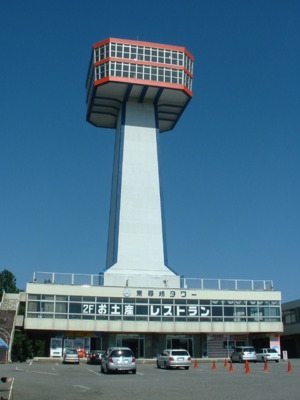
Tojinbo Tower’s top-heavy, boxy style is classic no-frills observation tower design from back in the day. From what I have seen, there used to be quite a few similar-looking towers in Japan, but probably due to their cheap construction and the waning popularity of the tourist sights they were built near, many of them have now been torn down (The other old popular observatory tower design fad was basically the same concept, except with cylinders). From the picture of the two Goryōkaku Towers from earlier, you can see that the old Goryōkaku Tower was another tower of the same style as Tojinbo Tower, and I’ve seen pictures of many other similar ones that were torn down without being replaced. It appears that Tojinbo Tower is one of the last of a dying breed, and it doesn’t seem like it has much time left either. Going off of reviews and recent, non-promotional photos, Tojinbo Tower looks to be the shabbiest and most run-down tower of the entire Rally. One reviewer, upon seeing the inside of the tower, remarked that it was as if time in the tower had stopped in the Showa era. At the very least, there was a lot of scaffolding on the outside of the tower when the reviewer visited, so they do seem to be keeping it maintained. If there is any sort of catastrophic failure, though, it’s the second-shortest tower in the Rally, so any drop won’t be that bad.

Other than being the most nostalgic, Tojinbo Tower is also distinguished among the towers of the Rally for being the only one that’s there to facilitate viewing/capitalize on nature, specifically the nearby cliffs of Tojinbo. Unfortunately, going based off the reviews again, it seems that the view of the cliffs from the tower isn’t even particularly good. In any case, I am just now realizing that this trip is severely lacking in nature, although it’s probably a good thing that they aren’t erecting towers all around beautiful natural scenery and spoiling it. For my next trip, though, I should try to balance things out by seeing if there’s any sort of Japan Waterfall Stamp Rally.
After finishing up at Tojinbo, the trip up the coast is continued to the biggest city in the area, Kanazawa. If there’s time left, there’s a few notable sights in Kanazawa such as one of the most impressive landscape gardens in Japan, but otherwise, there are of course a couple of cheap hostels for the night.
Day 15
Kanazawa is currently the end of the line for the Hokuriku Shinkansen, but although the Shinkansen viaduct passes by tantalizing close to our next destination of Oyabe, the town is too small to merit a Shinkansen stop. Even worse, JR sold the local rail line after they built the Shinkansen tracks in the area, so this next rail segment isn’t covered by the Rail Pass. The closest train station to the next tower in Oyabe is named Isurugi for some reason, despite everything else in the area bearing the name Oyabe. There is also no other train station around named Oyabe, so I really don’t know, must be some sort of historical reason. The mile or so between the train station and the tower is nothing but flat farmland, so you can navigate to the tower just by heading in the direction that you see it in.
The next tower is in the middle of this place called Crossland Oyabe. I know what you’re thinking: did they really build a Christian theme park in the middle of a bunch of farmlands in Toyama prefecture? No, as much as I wished they had, they did not. From what I can tell, the name (and the justification for the whole place) comes from the nearby expressway junction, which seems to be something of a Big Deal. One odd thing about Japan I never, ever hear anybody talk about is their nationwide network of toll expressways (This was entirely true until literally yesterday, when completely unprompted, someone I had pretty much just met happened to mention them). They’re almost more like railways, rather than highways. Making an entrance/exit on a toll highway is fairly involved due to requiring the construction of a toll plaza and all, so they tend to be only at the most important locations, just like railway stations. The toll booths are very similar to fare gates, with the tolls prices quite comparable to train ticket prices, both being based on distance as well. For example, the minimum toll to take the expressway from Tokyo to Oyabe (a trip of about 450 km) is about 7,000 yen, or 60 dollars (in fact, Japan’s highway tolls are some of the most expensive in the world). This resemblance to rail networks doesn’t seem to have gone unnoticed, because many expressway maps even look like maps of rail lines, with each expressway a different color, each exit/entrance as a stop, and junctions as transfer stations. What’s even more uncanny is that the history of the national expressway network seems to parallel that of the national rail network, just shifted forward a couple decades. The expressway network was originally initiated and built by the government, but mounting debts led to the split-up of the national highway company into several quasi-private corporations. This is pretty much exactly what happened with the original Japanese National Railways corporation, which was privatized and split into the various JR group railways that exist today.
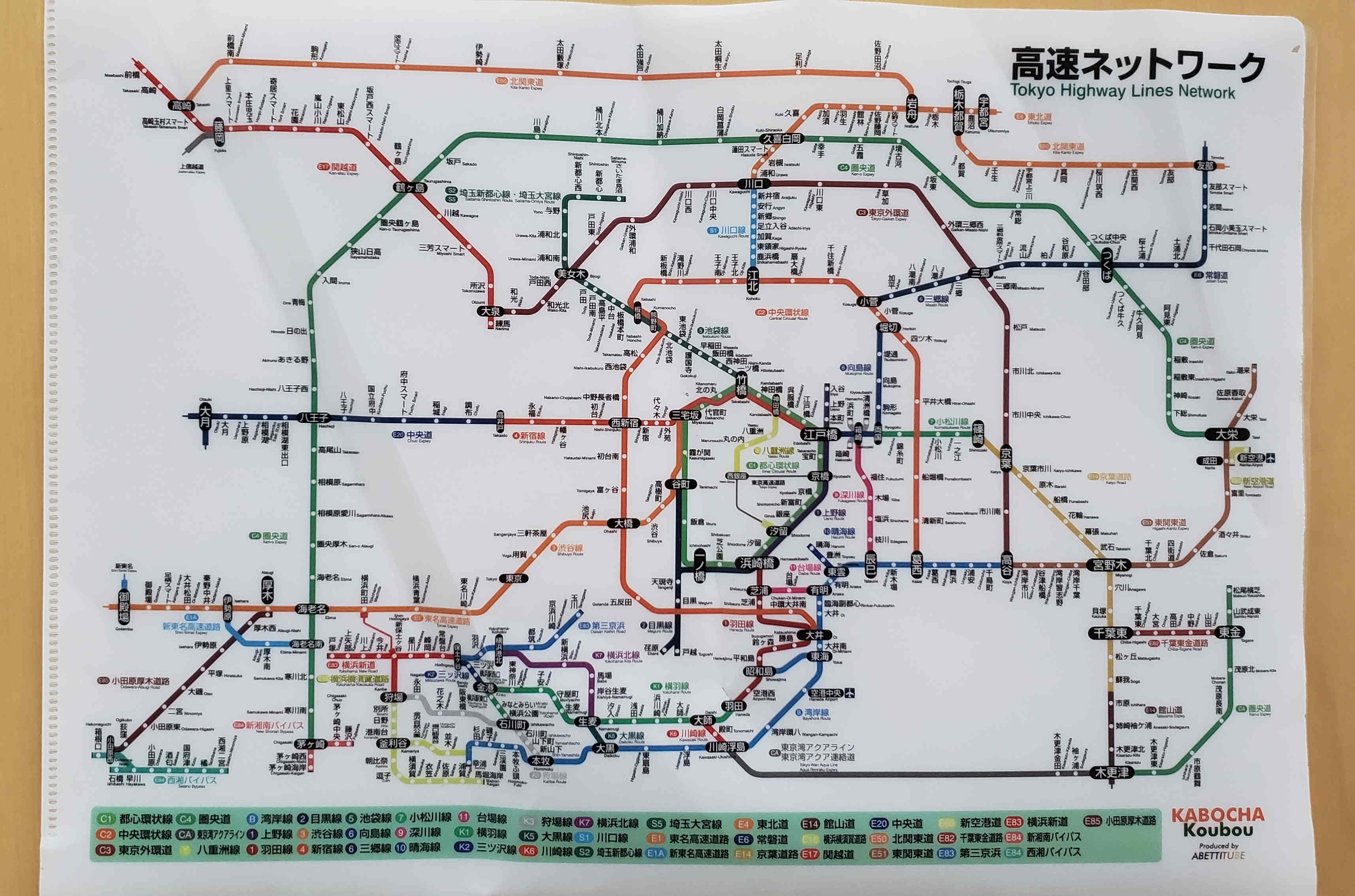
Crossland Tower
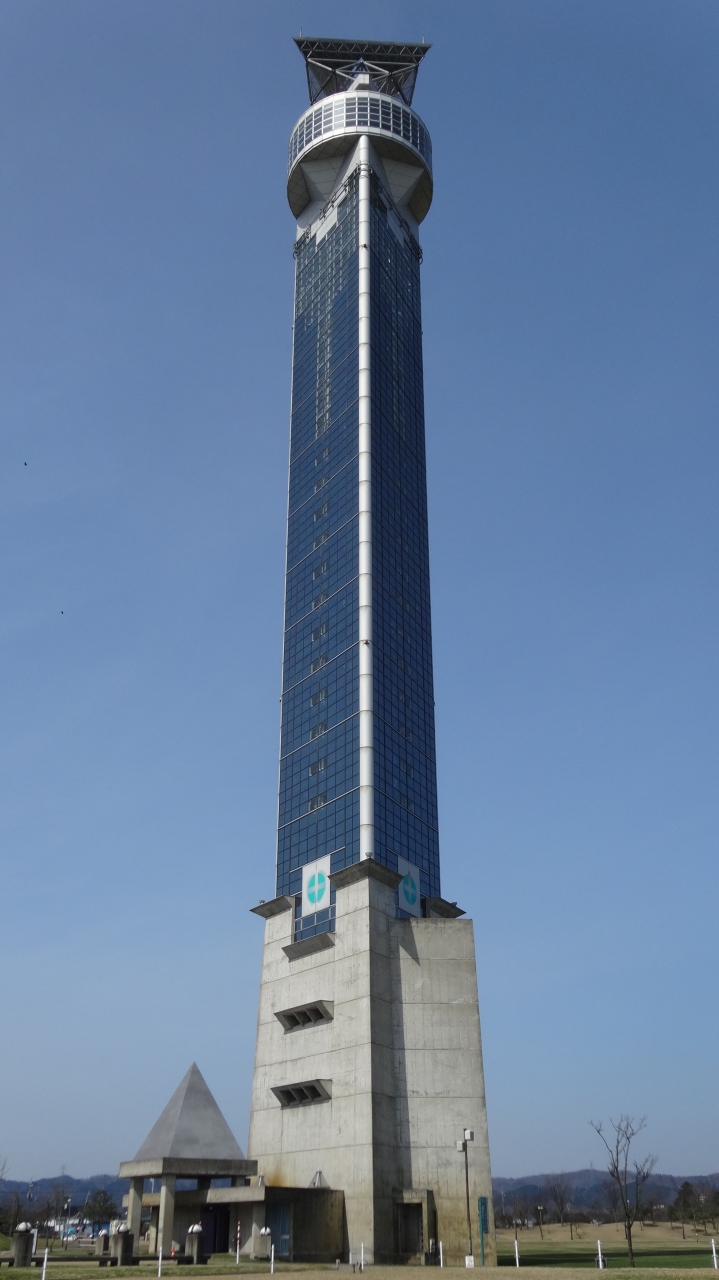
Anyways, back to Crossland Oyabe and its tower. So far, I have noticed that every tower in the Rally is either in a big city, right next to the ocean, or both. Crossland Tower must be the exception that proves the rule, as it’s in the middle of a “dispersed settlement” (a fancy way to say “bunch of farms and houses vaguely clustered together in a way that suggests a town but technically isn’t”) and isn’t particularly close to the sea. Recall that the best excuse they found for building it was that there was a notable expressway junction nearby. I’m not even sure what to call Crossland Oyabe as a whole, though, Crossland Tower’s strange home. It seems to be mostly a park, with all sorts of fun stuff for the kids, like a playground, minigolf, and a mini-train. There’s also an impressively hideous concrete building in that distinct Japanese brand of brutalism  from the 80s/90s (I don’t know what to call it, rondo-brutalism?)that is basically an events center for the area, with stages for performances and meeting rooms. And then, of course, there’s Crossland Tower, which seems modern and tasteful by comparison, being one of the “modern skyscraper”-type towers and containing a far more favorable glass-to-concrete ratio. The comparative tastefulness is amplified by yet another small rondo-brutalist building wrapping around the base of the tower that seems to be some sort of Da Vinci museum.
from the 80s/90s (I don’t know what to call it, rondo-brutalism?)that is basically an events center for the area, with stages for performances and meeting rooms. And then, of course, there’s Crossland Tower, which seems modern and tasteful by comparison, being one of the “modern skyscraper”-type towers and containing a far more favorable glass-to-concrete ratio. The comparative tastefulness is amplified by yet another small rondo-brutalist building wrapping around the base of the tower that seems to be some sort of Da Vinci museum.
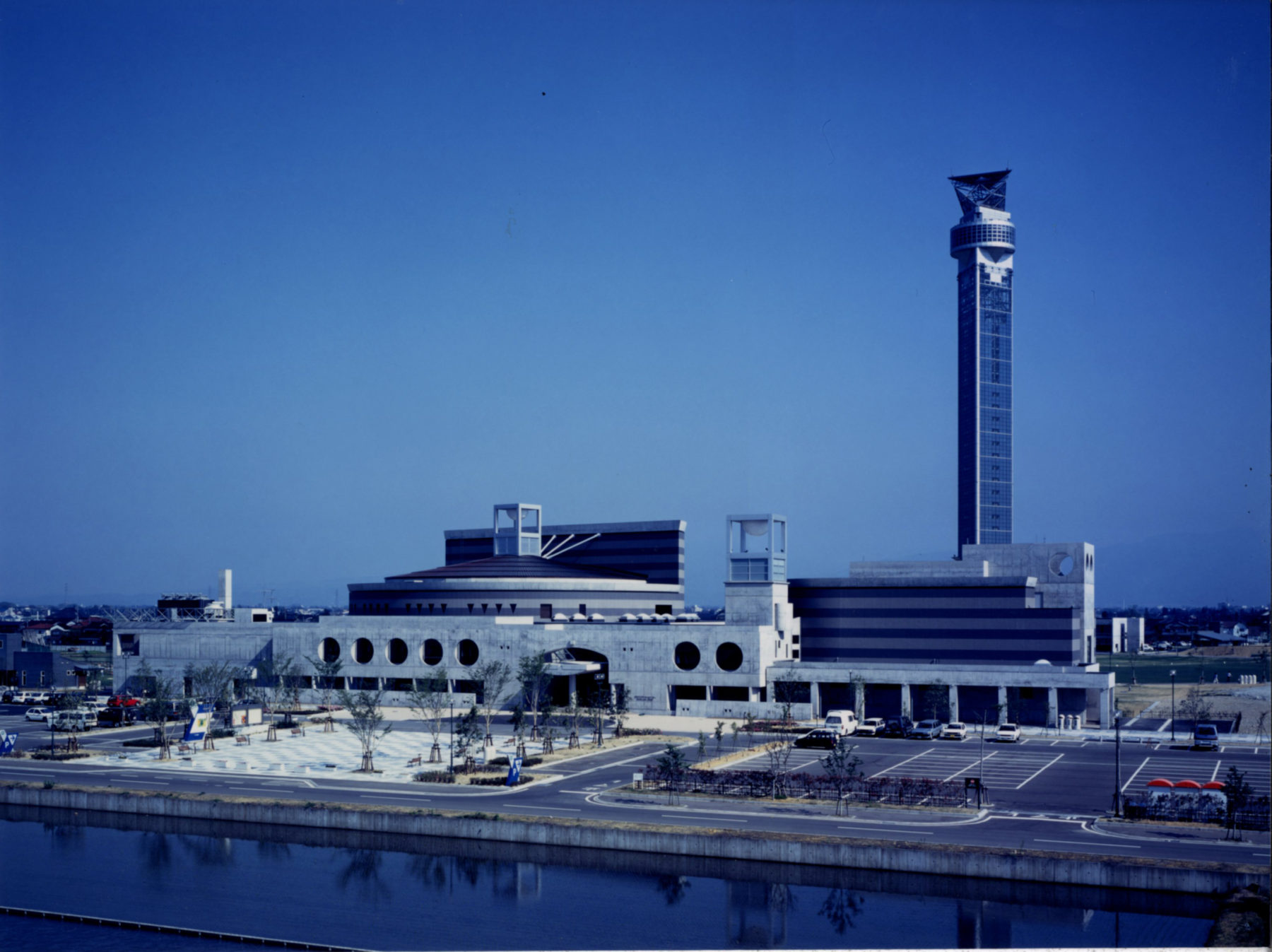
From Oyabe/“Isurugi”, it’s a quick hop on the private railway again over to the next sizable city of Toyama, where there should be at least one hostel for staying the night. Why stay the night up here so soon, instead of making a beeline down to the next towers in Nagoya? All will be revealed in time.
Day 16
The reason for staying the night in Toyama is so that Matsumoto can be included in the itinerary, as I’m quite partial to it and would love to visit again. This alone is not a reason to shack up early in Toyama, though, as Matsumoto can be reached fairly quickly (though admittedly in a bit of a roundabout way) from Toyama. Thanks to the Hokuriku Shinkansen, it’s certainly been possible to leave Oyabe, rejoin the Shinkansen at its next stop in Toyama, and make it to Matsumoto in the same day. There is, however, another route between Toyama and Matsumoto that’s far more interesting, slower even though it’s more direct. It is, of course, the Tateyama Kurobe Alpine Route.
I have had my eye on the Tateyama Kurobe Alpine Route for quite a while, just never found the chance to fit it in anywhere. It’s basically a scenic route through the mountain chain that lies between Toyama and the valley on the other side where Matsumoto is. In classic “the journey is the destination” style, the Route is a destination unto itself, containing beautiful mountain vistas, waterfalls, minor volcanic activity, and Japan’s tallest dam. The famous pictures of the dramatic “snow walls” on that one road in the late winter/spring that you may have seen circulating around, with tiny people walking or even buses going down the road like a river in a canyon are from the Route. The clever planner, though, can kill two birds with one stone, and also use it as a way to get between Toyama and Matsumoto. As if things couldn’t get any better, traversal of the Route involves a wonderfully diverse array of transit options for the discerning transportation fan like funiculars, an aerial tramway, and trolleybuses, which are all rare finds on their own. The one issue is that traversing the route takes the better part of an entire day, which makes a night in both Toyama and Matsumoto necessary. Luckily, it’s both on the way (sort of), and there’s enough flexibility in the schedule to give up a day to it. It’s a great chance to work some more nature into the trip (something I recently complained there wasn’t enough of), although even then, it still comes with Japan’s tallest dam in the bargain.
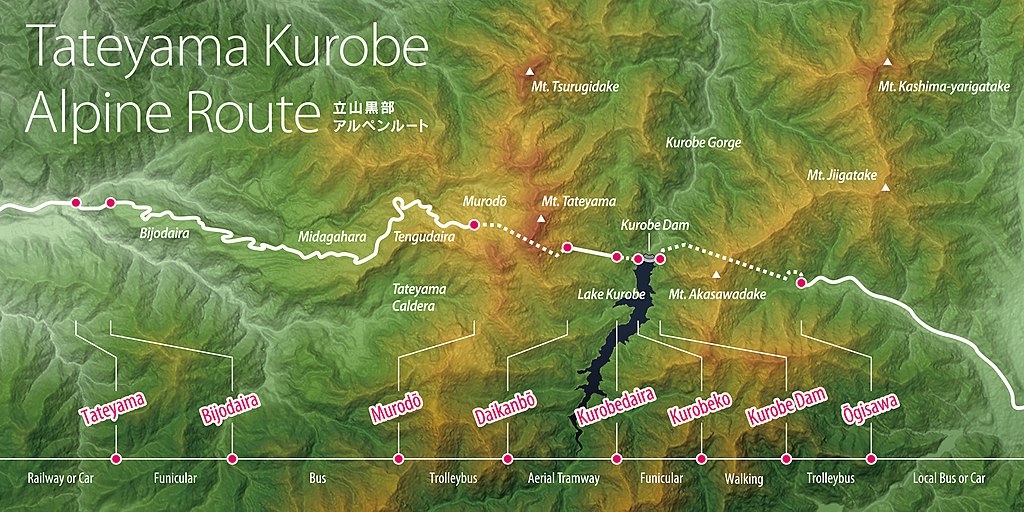
The terminus of the Alpine Route is the train station in Ōmachi, from which it is a short ride south down to Matsumoto. Matsumoto is a lovely little city, nestled in a valley in the midst of Japan’s mountainous interior. There’s a nice black castle, museums for a few random things (timepieces was one of them, I think), and of course, the real draw: the horse restaurant (exactly what it sounds like). The perfect place to spend a night before heading back to the hustle and bustle of the big city in Nagoya where the Rally picks back up. Luckily, despite Matsumoto's modest size and location, there’s still a good hostel in it.
Day 17
The JR Chuo Line runs directly from Matsumoto to Nagoya, though it’s still a two-hour ride on the limited express train, since nearly all of it is through a narrow, winding mountain valley. By this point, there have been more than enough scenic coastal rides, so now it’s time for (what I hope is) a scenic mountain ride. I really should know this, considering I have already taken this exact route before, but alas, I think I fell asleep. I can’t confirm this for sure, though, because Matsumoto is right where my trip journal ended prematurely, as they always tend to.
Japan’s third city, Nagoya. Yes, I know that technically it’s fourth by population, but Yokohama is basically part of Tokyo. In terms of tourism and sightseeing, I think it’s easily somewhere outside of the top ten, which is quite unfortunate considering its size. The only excuse I have ever found for visiting was to go to that venerable institution, the SCMAGLEV and Railway Park (of course), and even then, I was barely in the city longer than necessary to get there and then back on the Shinkansen out. However, at the very least, they aren’t slacking when it comes to towers, and I will finally be making an overnight stay in Nagoya to visit both of them. The towers aren’t that far away from each other so if I really did want to spend as little time as possible in Nagoya, I could get both of them done and then book it in the same day, but who knows, it’s possible I’ve had the city all wrong this whole time, and staying there for a decent amount of time (more than a few hours) will dispel my prejudices.
Nagoya TV Tower
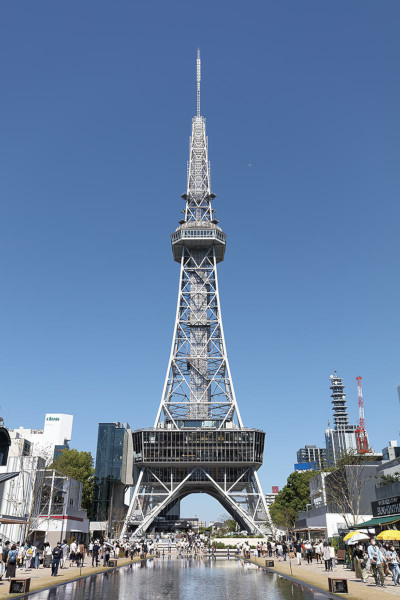
Like everyone, Nagoya got in on the TV (tower) craze as well. As with its sibling TV towers from that era, it would appear that its primary purpose is no longer really TV broadcasting. In fact, I even debated about whether or not to call it the “Nagoya TV Tower” here, as many sources, including the tower’s own website (which is nagoya-tv-tower.co.jp, I might add), are now calling it the “Chubu Electric Power MIRAI TOWER”. I wonder how long it will be until someone finally succumbs to all the clichés and puts “Yumemirai” in the name of a tower. The other towers with some sort of corporate sponsorship are content to leave the tower name unsullied and just slap some big glowing ads on the tower proper, but it seems to be the reverse in this case. Then again, maybe they haven’t had time yet to put up any ads, since the tower was renamed less than a year ago.
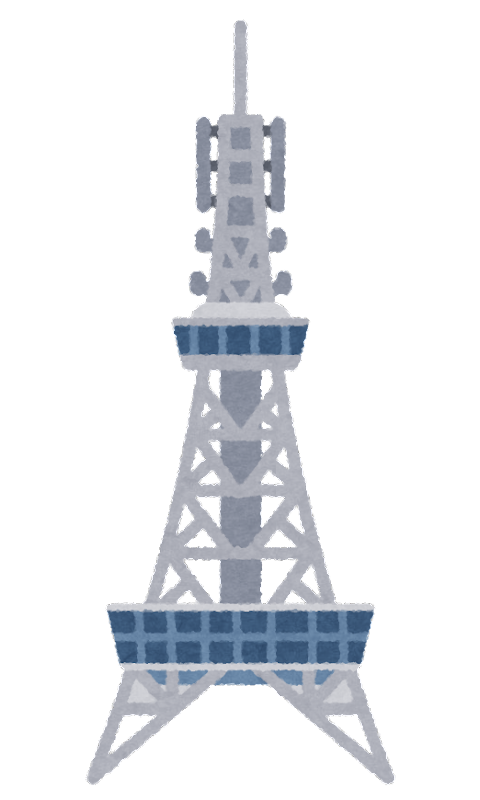
As for the tower’s design, that’s not déjà vu you’re feeling, no, it’s simply the unmistakable aura of yet another one of the Tower King’s works. There aren’t many towers left after this, but believe it or not, he will strike again so be on the lookout for it. In any case, after already seeing Naito’s other towers, the Nagoya TV Tower/Chubu Electric Power MIRAI TOWER’s design is nothing really to write home (or a webpage) about. However, it does seem like the area around it is rather unique among the towers located in urban centers. The tower is at the midpoint of a long and skinny park/low density retail corridor, a sort of extremely anorexic and partially colonized by commerce Champs de Mars, complete with its own version of the Eiffel Tower. I guess you could call it a promenade or an esplanade. This means that along the length of the park, you can get some very nice, clear views of the tower from a distance, with none of the tall buildings that might usually be in the way in the center of town.
Day 18
Here it is, the final day of the rail trip. It should be a relatively easy day since all that needs to happen is one more tower visit in Nagoya, and then a quick Shinkansen ride down to the next temporary base in the Osaka area. Using the Rail Pass will have to wait until later, though, since the next tower to the west of the city center can only be accessed by the city subway.
Higashiyama Sky Tower
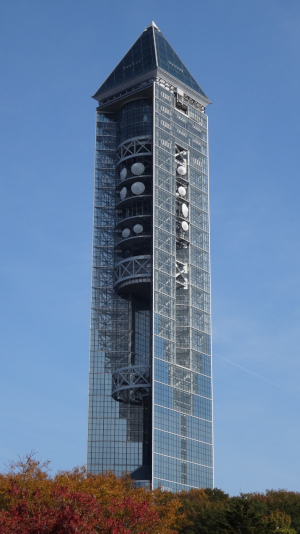
Higashiyama Sky Tower is Nagoya’s more modern tower. It looks like it’s still sort of under construction, to me at least, because part of the way up, they switch the façade from reflective glass to transparent glass, which makes the inner support structure visible. All the other modern skyscraper-looking towers go with the reflective glass all the way up, so as a result, Higashiyama Sky Tower by comparison looks like it’s not quite finished. I do quite enjoy the big glass pyramid capstone at the top of the tower, which feels really fresh for Japan, because usually they go with spheres (or cones). See, for example, the nearby Nagoya Science Museum, our old friend Kaikyo Yume Tower from earlier, the famous Fuji TV building in Odaiba, the Hitachi Civic Center, etc. It still manages to give off slightly ominous vibes, but at the very least the point is pointed away from the Earth, towards space invaders perhaps. No word on whether or not the pyramid is the "first of its kind in the world" like Kaikyo Yume Tower's glass orb. I think, though, if it had some dubious claim to fame, they would certainly brag about it.
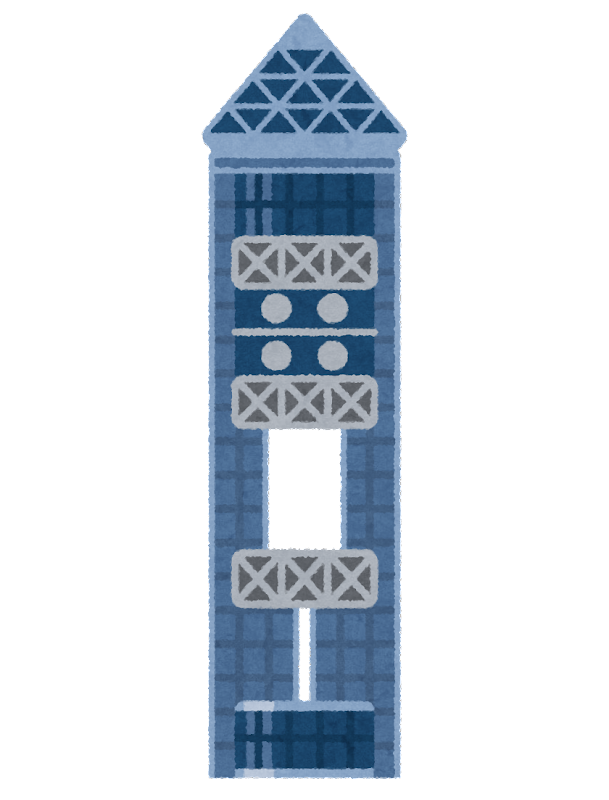
If any suspended monorail fans have managed to stick around all this time, there’s an unexpected treat nearby. I wasn’t expecting suspended monorails to make another appearance, however much I may have wanted them to, but it seems that towers and suspended monorails share some kind of mysterious cosmic link and tend to crop up near each other. They are Yin and Yang: the tower, anchored to the ground, rises towards the sky, and the suspended monorail, anchored from the sky, is pulled towards the ground. Or both of them happen to be in the same place because Higashiyama is a whole zoo/amusement park kind of deal and they just built a lot of novelty stuff there. Regrettably, the suspended monorail at Higashiyama was actually closed and torn down many decades ago, although it does seem like they have a boring old regular monorail that’s still operating. However, in one of the far corners of the park, hidden by trees and suspended above a refreshment stand, there is still one final suspended monorail remnant remaining: one short section of suspended track, just long enough to also preserve one monorail car clinging to it.
With the final tower of the rail trip checked off, it’s time to head down to Osaka and finish up the rail trip as well. Several dozen hours spent on trains and several thousand kilometers travelled, for a total of eleven tour visits over two weeks. Now, only four towers and four days remain.
Osaka Area
The four remaining towers in/near the Osaka area are all relatively close to each other, so if you were so inclined, you could theoretically visit them all in one day. However, as in Tokyo, instead I think it would be better to take it a bit slower, and let each tower anchor a full day of sightseeing.
Day 19
Umeda Sky Building/Kuchuu Teian Observatory
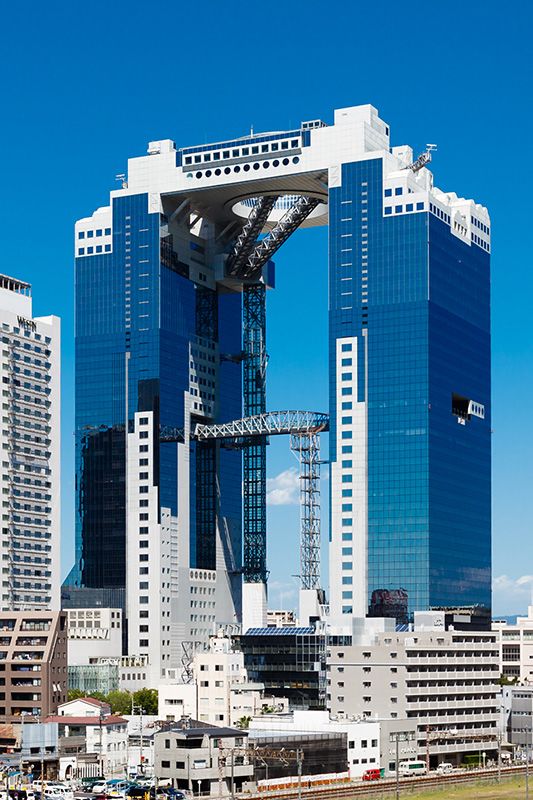
So far, we’ve seen a lot of different tower designs, some more questionable than others. The one thing that there was never any doubt about, though, was that they were all towers. Now we have finally reached the point in the Stamp Rally journey where we begin the question the very meaning of the word “tower”, which we took for granted for so long. Just look at the attached picture of the Umeda Sky Building. In fact, even before that, consider the fact that it is called the Umeda Sky Building and not the Umeda Sky Tower. I have it on very good authority, by the way, that technically towers do not count as buildings. Don’t ask me why, all I know is that’s just how it is.
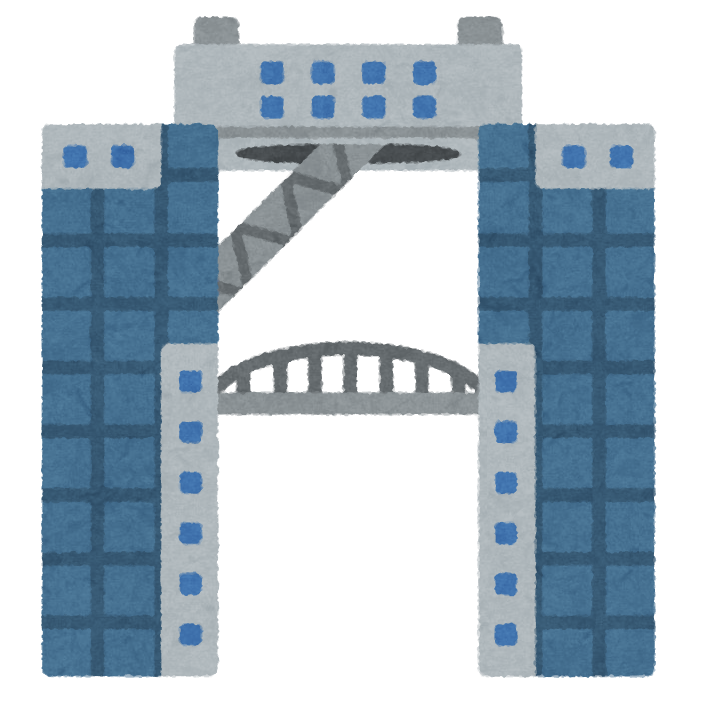
Anyway, now take a look at the picture, and tell me: does it depict a funky 90’s futuristic skyscraper office building with a big chunk taken out of the middle and some leftover scaffolding/crane-looking stuff (actually permanent parts of the design it seems), or a tower. If I showed you a picture of it from the side where there’s no chunk taken out of it, would you even be able to tell that it’s not just any other highrise? I rest my case. If the Umeda Sky Building makes the cut, you might as well start adding every tall office building with an observatory area at the top, which is the majority of the tallest ones. I just looked it up, and eight of Japan’s ten tallest buildings (not towers!) have observatories at the top, or near the top. Perhaps someone should make an All-Japan Building Association Stamp Rally of all the tallest buildings, which would be a far better fit for this particular “tower”. But, for now, it’s in the Tower Association Stamp Rally, so I’ll begrudgingly visit it and dutifully collect my stamp. At least it is mercifully close to Osaka station.

Day 20
Kyoto Tower

Kyoto, the historic city. Out of respect, most of the big buildings, even in the downtown area, are kept to a relatively modest height. The Kyoto skyline is sullied by only one thing: yes, that’s right, they really couldn’t resist it, they had to put in just one tower, back during the height (ha ha) of tower mania in the fifties and sixties. Not only that, but they really had to go all out and give it an aggressively modern design (well, sixties modern. As we are now well aware, modern-modern means GLASS). It sprouts like a thin white mushroom from the top of somewhat-dated building across the street from Kyoto Station building, which I’m sure used to be nondescript, but sometime in the nineties was transformed into a sprawling glass monstrosity that rivals even the tower in its defiance of Kyoto’s traditional spirit. A great first impression, making tourists wonder if they’ve accidentally stepped out of the train in the future (90’s edition) instead of in Kyoto. Incidentally, the same architect (Hiroshi Hara) who designed the Kyoto Station building was also responsible for the dubious “tower” we just saw, the Umeda Sky Building. 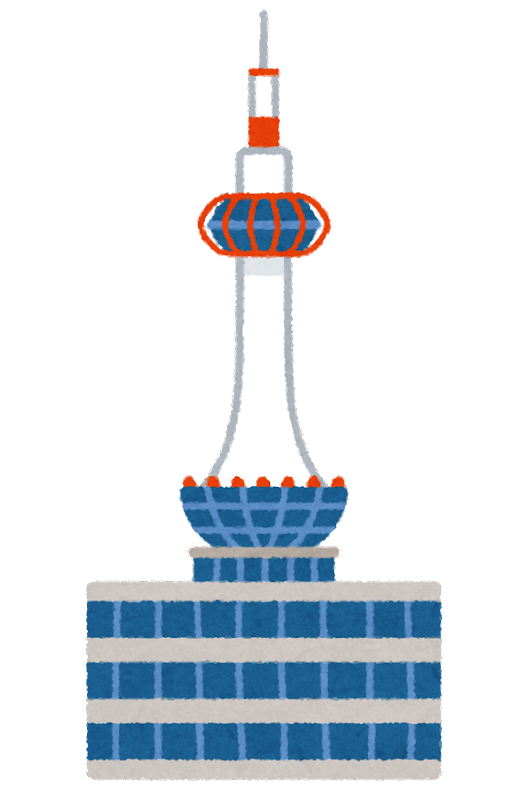 Anyways, as is common for somewhat unusual designs, they have an explanation: apparently, Kyoto Tower supposed to look like a Japanese candle. I can’t really speak to the accuracy of the depiction as I don’t really know anything about candles, let alone Japanese ones, but I’m still not entirely convinced that it’s not just a giant missile, hiding in plain sight. It doesn’t help that they of course painted some of the top parts with the same “International Orange” color they used for Tokyo Tower and other antennas, which also brings to mind aviation and missiles.
Anyways, as is common for somewhat unusual designs, they have an explanation: apparently, Kyoto Tower supposed to look like a Japanese candle. I can’t really speak to the accuracy of the depiction as I don’t really know anything about candles, let alone Japanese ones, but I’m still not entirely convinced that it’s not just a giant missile, hiding in plain sight. It doesn’t help that they of course painted some of the top parts with the same “International Orange” color they used for Tokyo Tower and other antennas, which also brings to mind aviation and missiles.
Day 21
Kobe Port Tower

Finally feel like I’m running out of steam when it comes to writing about towers... What can I say about Kobe Port Tower? It’s red... maybe... I’m colorblind so it could easily be green... guess it’s cool they chose a color other than International Orange or white. The design is pretty unique but it just doesn’t stir anything in me... mostly I’m just reminded of climbing on these rope lattice playground structures that sometimes cropped up when I was a kid that were, for some reason, usually made using red ropes... meanwhile the shape of the tower brings to mind the Chinese yo-yo, which also appeared occasionally in my childhood... Apparently the actual inspiration is a sort of Japanese drum called a tsuzumi, and I have to admit it’s a pretty good likeness, although the tower is a lot taller and skinnier in proportion to the drum pictures I saw. Interestingly (or probably not), Kobe Port Tower is not the only building inspired by this type of drum, with one of the entrance gates at Kanazawa’s JR rail station visited on Days 14/15) also based on it, although with the red ropes represented by wood beams rather than red poles.
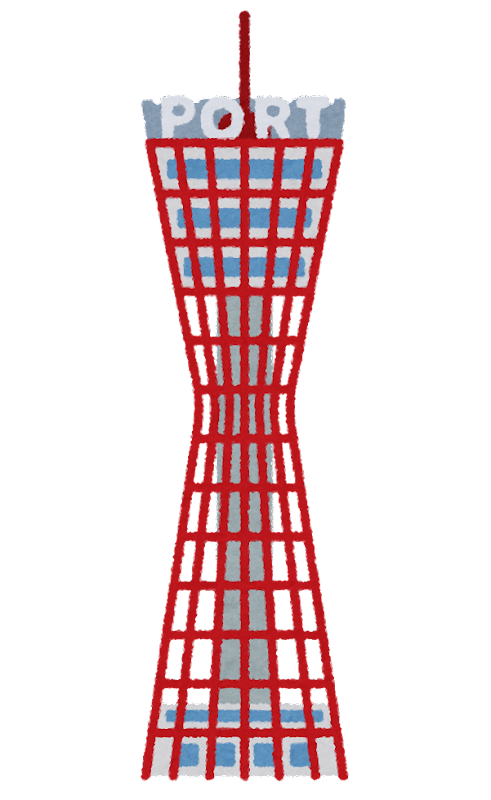
At this point I started taking more interest in the drum than the tower, especially because the English Wikipedia articles on the two variants (big and small) go weirdly in-depth about a bizarre set of quirks particular to each style which are not mentioned at all in the Japanese counterpart. According to the articles, the small tsuzumi needs a certain amount of moisture on the head to produce the best sound, which players achieve by breathing or even putting spit on the head before playing, and then further breathing on the drum during breaks in a performance. Meanwhile, the head of the large tsuzumi must be kept dry at all costs, to the point where they will heat up the drum before a performance. Also, the large tsuzumi drum heads, if properly taken care of, only last for ten performances. There’s more in the articles, but I’m honestly starting to wonder if all this stuff might just be made up as the small tsuzumi article cites one source that doesn’t mention any of that, and the big tsuzumi article has not a single citation, link, or reference of any sort. A cursory Google search didn’t reveal any websites to corroborate, although this doesn’t say a whole lot as Google searches have become pretty garbage lately. If I go to the library, I’ll do some old-fashioned research and see if I can find a book or something on Japanese drums, and report back here.
Day 22
Tsūtenkaku
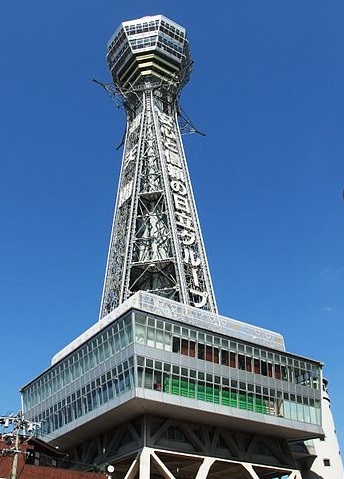
At last, the final tower. It could only be Tsūtenkaku. It MUST be Tsūtenkaku. Yes, I have deliberately saved my beloved Tsūtenkaku for last, as my favorite tower in the whole Rally. From the name alone, you can already tell this tower is something special. No pussyfooting around with boring old town names or hackneyed words like “yume” or “mirai”: Tsūtenkaku literally means “Tower Reaching Heaven”, which some may contend is unsuitable not due to its presumptuousness, but because the tower is itself heaven. Aside from the name, though, how can I be so assured of its excellence? Besides Tokyo Tower, it’s the only other tower in the Rally that I’ve already been up in. Speaking of Tokyo Tower, yes, Tsūtenkaku is in fact the last tower in the Rally designed by our old friend, Japan Tower Design King Tachū Naitō, that I hinted at earlier. Truly full circle.
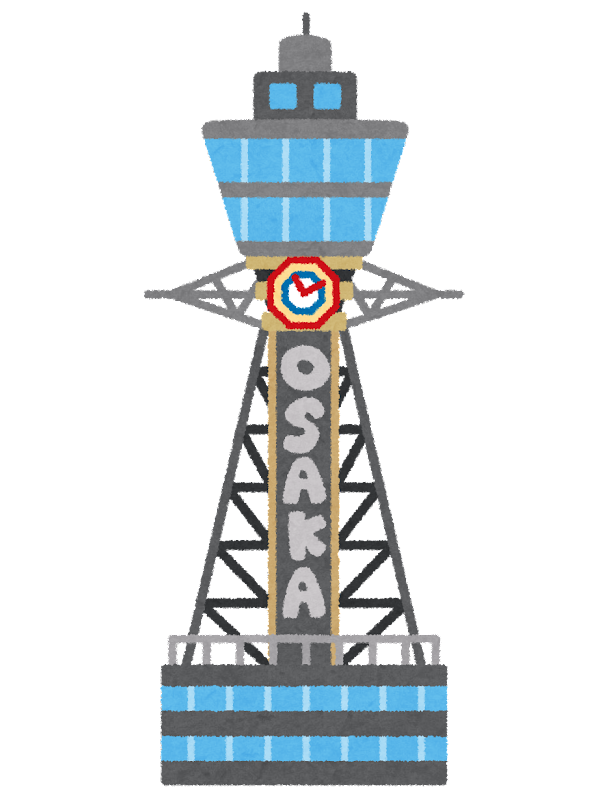
In any case, since I’ve actually been there, there’s so much I could say about the tower and the area around it. It is unapologetically a tourist destination and symbol; the only thing it has ever broadcast is vibes, and the eternal neon Hitachi advertisement shining up its height. It’s absolutely brazen, shameless, practically insulting how in-your-face it is, a perfect representation of the Osaka attitude. Tsūtenkaku is the centerpiece of perhaps the most unique neighborhood in Osaka, Shinsekai. The name literally means “New World”, but nowadays its appeal comes mainly from its retro atmosphere. It was notorious for criminal activity and poverty for decades which reduced investment in the area and thus preserved old buildings, and now that's contributing to a reversal of fortunes as tourists come in to take in the vibes. One wonders how long the charm can last if the area starts getting popular enough to result in lots of investment and ambitious redevelopment projects. I guess that’s some mono no aware for you right there.
Like in some sort of seemingly-paradoxical Zen koan, to go up in Tsūtenkaku, you must first go down. Down into “Wakuwaku Land”, a colorful line-up of giftshops that almost makes you forget you’re underground. Usually it’s “exit through giftshop”, but in Tsūtenkaku’s case it’s “enter and exit through giftshop”. The giftshop is also the ticket booth, and once you have the tickets in hand, you walk down a hallway to the elevator that takes you up to the bottom floors of the tower. The tower’s legs are too small to host any staircases or elevators (something you may notice if you happen to walk directly under it), so the elevator is actually in a dinky cylindrical tower right next to Tsūtenkaku. They refer to it as the “EV Tower”, and after hours of research I was able to determine that EV stands for elevator. If you want to go back down from the bottom floors of Tsūtenkaku, however, there is now an additional option besides the elevator. Less than a week ago as of writing, they have opened up a freaking SLIDE called the Tower Slider that curls around the EV tower and deposits you back underground. I guess they haven’t had time yet to take any actual pictures, but the 3D mockups on the website make it look incredible. It’s completely on brand, and the only con is that it costs a thousand yen per go, which is actually more expensive than admission to the observation deck. Shows you where the real money is made in the tower biz.

So what do they have in the bottom floors of the tower? More gift shops, of course. This time, though, it’s also broken up with several monuments to various titans of Osaka culture, like Kinnikuman and Shinsekai’s de facto mascot Billiken. Once you endure the temptations of the giftshops, finally there’s another elevator in the center that takes you up to the observation deck. There are two floors to the observation deck. One of them is decked out (heh) in gold and Billiken. When I visited, there was some sort of collaboration going on between Tsūtenkaku and Hatsune Miku, so the other floor had been converted into a sort of dance floor with disco balls, flashing lights, and speakers blasting an assortment of Vocaloid songs. It was pretty lucky that I visited at night, otherwise the atmosphere would have been a bit off. There was a lot of art around of Osaka Miku and Miku dressed to look like the tower, of which they even had a cardboard cutout of that I had some fun with.
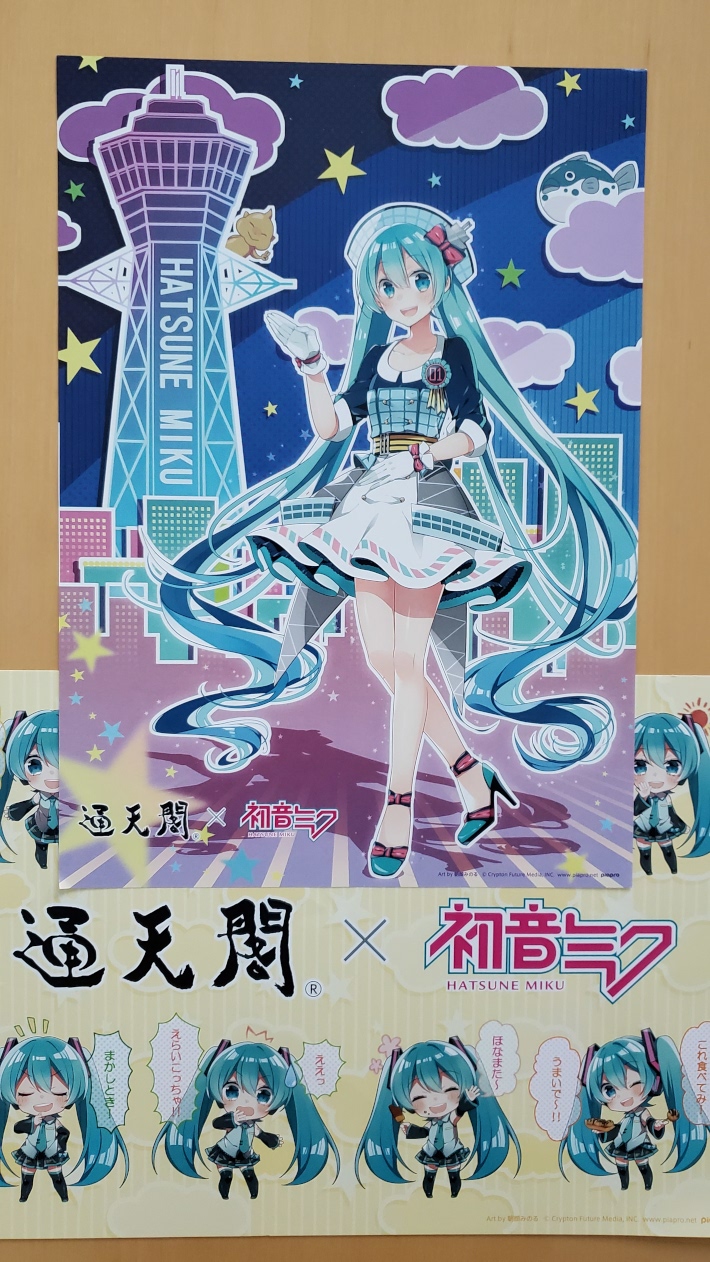
I hope they have kept at least some of the party setup intact as it appears from the pictures online, because it would be the ideal venue to celebrate my ascension to the title of “Tower Master”, which from that moment forward I will insist people refer to me as. Then, after the festivities, I will of course descend in style via the slide. “Things as they ought to be”, as Billiken assures.
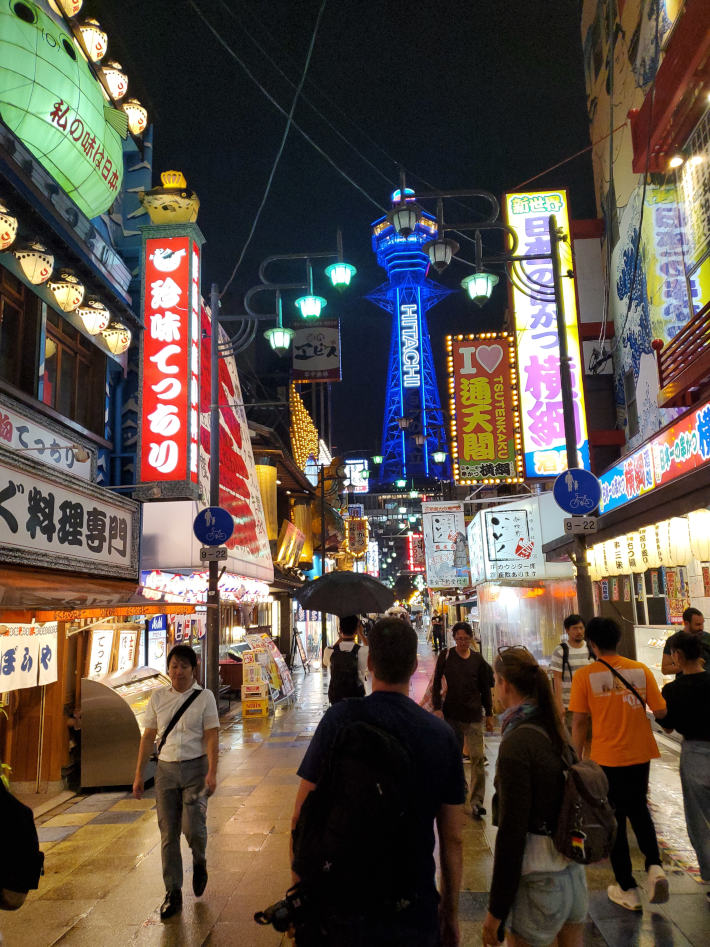
Conclusion
I genuinely went into this intending to just put together a simple itinerary based around completing the All-Japan Tower Association Stamp Rally, which I had recently realized would form the perfect theme for another rail trip across Japan. To plan it out, I put all the tower names into a Word document, and started to string together a tentative order for the visits, labelling the days as I went. Once I had established the basic strategy and outline, I went through and started to iron out the details, shuffling the order around a bit and writing down more detailed notes. Then I started really scoping out the towers in StreetView, going on their websites, Wikipedia, tower fan websites... and things really escalated from there until I suddenly found myself collecting pictures and writing extensive descriptions of the towers I found most interesting...
As the page count rose, I started to realize that I had accidentally stumbled into my next writing project. I was itching for something new after finishing up my Minecraft memoir, but I couldn’t find any topics that inspired me enough. It wasn’t clear exactly what kind of writing the towers would turn into, however the passion certainly seemed to be there for them, so I just decided to go with it and see where it ended up. It ended up somewhere, that’s for sure, though I still don’t really know where. Is it merely an excessively embellished itinerary, like some sort of modern illuminated manuscript? A series of digressive, tower-themed vignettes, capturing the spirit of a late-night Wikipedia binge? The foremost work of architectural criticism on Japanese towers? A travel memoir detailing several real and imagined tower visits?
What I eventually settled on was “speculative travel writing”. As far as I know, it’s a completely new genre. Sometimes these things happen, you set out to plan a trip and accidentally discover (or create?) a new genre of writing. I will stay humble, though, and acknowledge that most likely somebody has beaten me to the punch on this one. If you’re aware of any other works of speculative travel writing, go ahead and send them my way, I’m curious.
In any case, I fully intend to carry out the itinerary one day and claim the title of Tower Conqueror for myself, perhaps even write a piece of non-speculative travel writing about the journey for comparison. The shot and the chaser, or maybe the chaser and the shot depending on how things go. However, I’ve already spent so many hours researching the towers, walking to and around them in StreetView, poring over images, and writing down my impressions, that it practically feels like I’ve already been to them all and completed the Stamp Rally... as such, I hereby award myself the following Honorary All-Tower Conquest Certificate that I threw together in Word just now.
Postscript I: Mystery of the Missing Tower
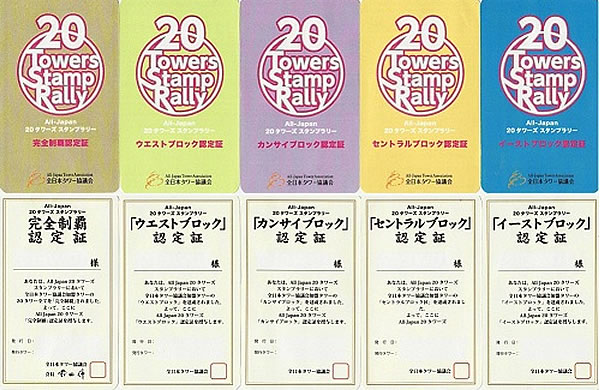
While looking over some of the older promotional material for the All-Japan Tower Association and the Stamp Rally, something caught my eye: they kept referring to it as the “20 Towers Stamp Rally”. Soon enough, I started noticing it everywhere, referenced on old Japanese tower otaku blogs or mentioned in the dusty, cobwebbed corners of official tower websites that someone likely forgot to update. What was the missing tower and what happened to it, I wondered. Was it in some long-forgotten corner of the country, forced to shut down when the tourists stopped coming, like so many towers not in the association? Or perhaps something more dramatic happened, like it was felled by one of the myriad natural calamities (earthquake, tsunami, eruption) that call Japan home? As a seasoned internet sleuth, it wasn’t long before I dug up the anticlimactic answer: it was both still standing and in business.
Gold Tower

Gold Tower, or “Play Park Gold Tower” as it is sometimes referred to (there seem to be some attractions for kids at the base), is located on the smallest of the four main Japanese islands, Shikoku. It’s in a small town called Utazu on the coast facing the Seto Inland Sea, right by where the Great Seto combined road/rail bridge connects Shikoku to the main island of Honshu. It’s a bit of a shame, as now there are no towers in the Stamp Rally on Shikoku, and Gold Tower is well-positioned by the bridge and railway so it would not have been too hard to fit into the itinerary as a small detour. For its modest location, Gold Tower is a surprisingly tall tower (158m), and if it was still in the Association, it would be the fifth tallest, barely edging out Kaikyo Yume Tower for the position behind the dubious “tower” that is the Umeda Sky Building. But why build such a huge tower in such a location? Sure, it has good views of the Great Seto bridge, but there’s already an elevator-type observation tower that’s far closer to the bridge, pretty much for the express purpose of viewing the bridge. Luckily, while conducted unrelated research the other day, I happened to stumble upon the answer, which in retrospect also explains the genesis of many other towers in the Association.
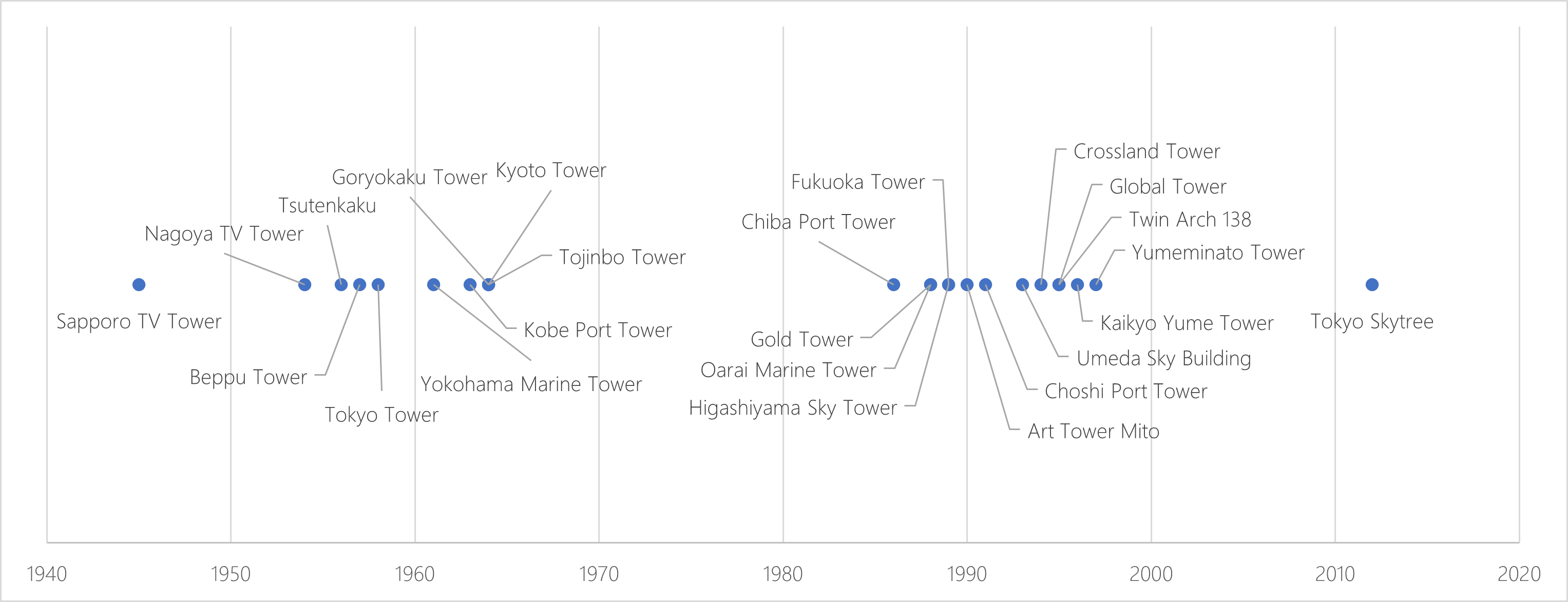
Above, I’ve put the opening years of every tower I’ve mentioned so far, 24 in all, on a timeline. There’s two clear clusters, or perhaps “tower booms”, one from 1954-1964, and one from 1986-1997. The first tower boom, which we can perhaps call the “Post-War Tower Boom”, coincides with Japan’s first post-occupation economic booms: the Jinmu Boom (1954-1957), the Iwato Boom(1958-1961), and the Olympics Boom (1962-1964). The towers built during this time, which start off with quite a few designed by our old friend the Tower Design King, are either practical TV towers or observation towers aimed at the increasingly prosperous population, buying TVs and travelling around. The observation towers are either in notable tourist destinations cities like Kyoto or Yokohama, or landmarks that would clearly benefit from an observation tower (Tojinbo, Goryokaku). Tsutenkaku in Osaka was built to replace a beloved landmark tower that had burned down, and once upon a time, Beppu was the Las Vegas of Japan. The key takeaway is that the locations for all the towers made sense, financial and otherwise.
Then, there’s a gap of almost twenty years with no significant towers built, with the tower-building picking up again in the mid-eighties and leading into the second tower boom. But this tower boom was fueled by something a lot more sinister... those familiar with Japanese history probably know where this is going. Yes, the second tower boom, an appropriate name for which may be the “Bubble Tower Boom”, coincides with the infamous Japanese asset price bubble of the mid-eighties to early nineties (it may seem like the towers built after 1992 or so are too late to have been products of the bubble, but keep in mind that it can take several years to plan and build a tower. Also, although the asset prices had collapsed by 1992, it still took several years before the effects were fully felt, especially the further you got from the big three cities).
Long story short, during the bubble era it was extremely easy to get huge loans, so many businesses and municipalities embarked on extremely ill-conceived construction projects, which of course ended up including quite a few towers. This is where we find a lot of towers built for the sole purpose of becoming a landmark unto themselves, with the intention to draw tourists out to small, out-of-the-way towns with not much else going on, like Mito, Yonago, Choshi, Ichinomiya, Shimonoseki, Oarai (keep in mind this was decades before the tank anime). For similar reasons, additional towers were also built in some big cities that already had older, established towers like Nagoya, Osaka, Fukuoka, and Beppu. Unfortunately, this turned out to be wishful thinking, as it turns out there’s only a few tower maniacs (like me) who are willing to travel all the way out to the boondocks just to visit a tower, in addition to the fact that tourism as a whole declined due to the post-bubble recession. In the cities where towers were added, they had difficulty competing with the older, established towers with better locations, many of which had also achieved icon status already. So, the sad truth behind many of the bubble boondoggle towers is that they’re now burdens to the communities they were supposed to invigorate, monuments to a bygone age, an age of high hopes for the future, but also an age of greed, delusion, and false prosperity.
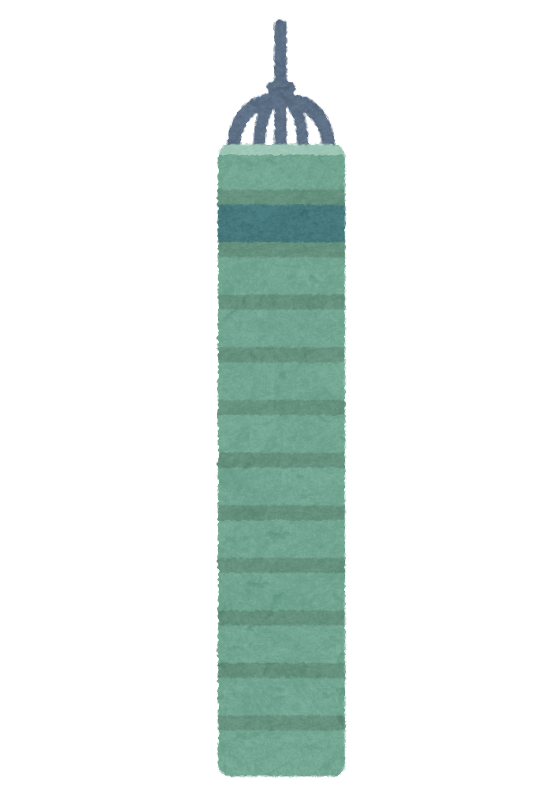
It is in this category that we find Gold Tower, and it is in this context that I happened to stumble upon a reference to it. In an ancient blog post by an old Japan blogger who could be deemed a sort of “Bubblologist”, he mentions the Gold Tower as being in the running for the title of one of the “Three Great Structural Legacies of the Bubble”, monuments to the excesses of the Bubble that have still somehow endured to this day. An overly-huge tower in a humble town is the perfect example of the mindset that dominated the Bubble, and ultimately led to its collapse. And of course, what could signal excess more than the ostentatious gold color of the tower as a whole, from which it gets its name?
One question still remains unanswered: why is Gold Tower no longer in the All-Japan Tower Association? I dug around, and eventually found a notice on the Japanese website of the Association that said that Gold Tower was withdrawing from the Association due to “circumstances” (都合), a classic use of a Japanese business weasel word. We may never know the real reasons, but I poked around a bit longer, and it seems there’s been some extensive financial reorganization over at Gold Tower lately, including some transfers of ownership. The sort of thing that may indicate financial trouble, of the sort that happens when you take out too much debt to build an expensive tower out in the middle of nowhere that not enough people are visiting. I don’t know if the Tower Association has membership dues, but if it does, perhaps the new accountants trimming the fat decided it was no longer worth it. Will this be the start of a reversal of fortunes, or a slide into ruin for the tower, I wonder.
